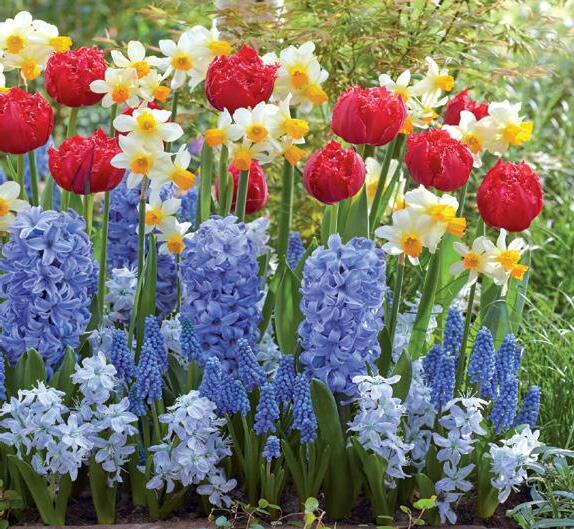
58 minute read
News For Autumn 2023
Superior Bulb Planters
We now offer a range of RHS endorsed Burgon & Ball planters. These premium quality tools are built to last a lifetime, and they are designed to be the ultimate aid for gardeners.
Long-handled Bulb Planter measuring 100 cm (39”) costs just £29.08 (ex. VAT).
Order code SPL10.
Hand Held Bulb Planter measuring 36 cm (14”) costs just £14.92 (ex. VAT).
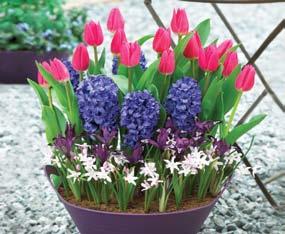
Order code SPS20.
Fresh Cut Flowers
Top Quality, Fresh Cut Flowers
Celebrate those memorable moments, impress that special someone – or just brighten up your home. Our beautiful hand-tied bouquets use only the freshest cut flowers, bringing homes to life with gorgeous colour. We select the very best of seasonal flowers to create our special arrangements.
With a choice of six sumptuous bouquets in a range of sizes, there’s something for every occasion, every home and every pocket.
The useful Dibber measuring 40 cm (16”) costs just £14.08 (ex. VAT). Order code SPD30.
Top Quality Greeting Cards
All Greeting cards in this exclusive collection measure 127 mm x 127mm (5” x 5”), comes in a pack of 8 different photographs, supplied complete with premium quality envelopes.
One pack of Top Quality Greeting Cards only costs £4.04 (ex. VAT).
Order code: SGC11
De Jager Bulb Magic
This unique feed has been specifically developed to enhance the performance of all bulbs.
de Jager Bulb Magic is fast acting, easy to use, environmentally friendly and promotes vigorous growth to produce bigger and better blooms.
One litre of Bulb Magic dilutes to make up to 180 litres and costs just £8.29 (ex. VAT).
Order code: SBM01
Find out more and order your bouquets online now at www.dejagerfreshflowers.co.uk or call us on 01622 840229.
Outdoor Collections For Pots And Tubs
Our collections provide a magnificent display with attractive colour combinations. These are featured on page 1.
All individually packaged and clearly labelled with planting instructions.
Top Quality, Top Size Bulbs
Flower Bulb Specialists Since 1868
Dear Sir/Madam
I am delighted to be sending you our new Autumn 2023 catalogue containing over 700 bulb varieties to flower next spring, of which more than 125 are either completely new to our lists, or reintroductions of old favourites. Again, I would urge you to order early to avoid disappointment: the weather and therefore the harvests can be unpredictable, and there is always the chance of encountering shortages of some bulbs later in the year.
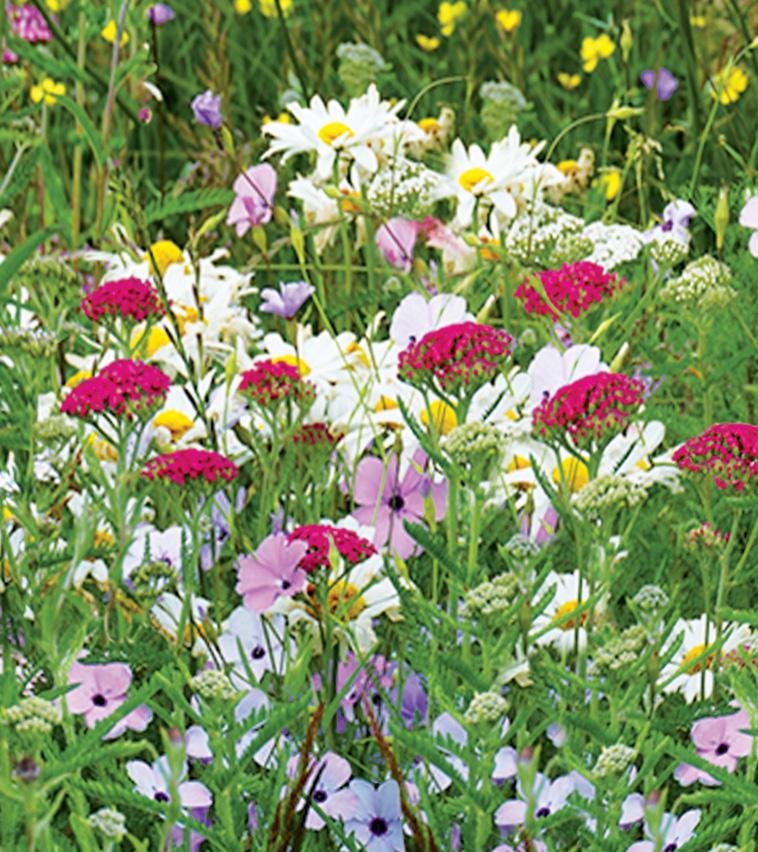
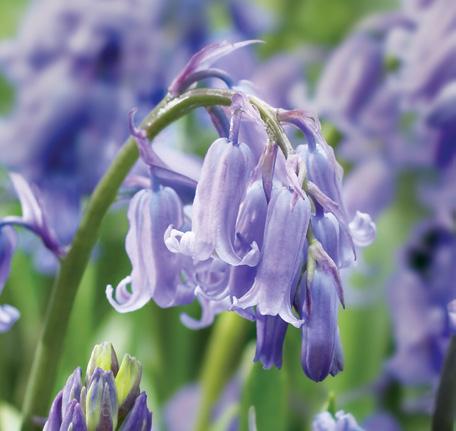
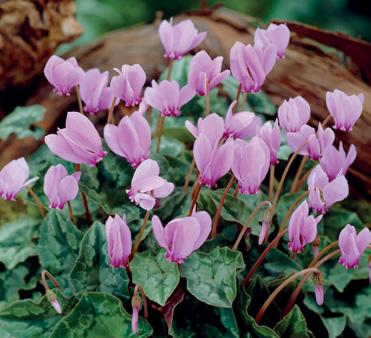
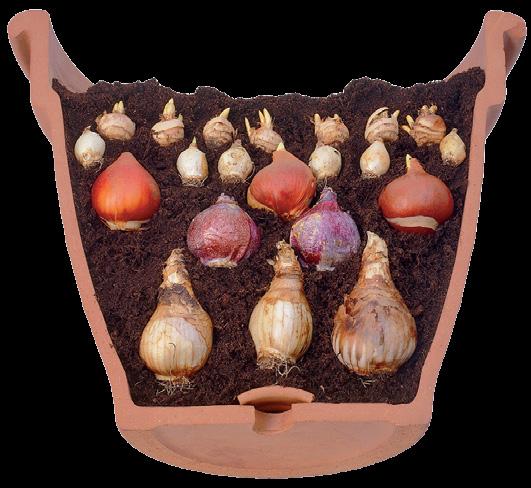
We have recently had the great pleasure of seeing the Coronation of His Majesty King Charles III and Queen Camilla. The splendour, pageantry and meaningful nature of the occasion were deeply moving, and it certainly made me extremely proud to be British. Both the King and the Queen are known to be keen gardeners and environmentalists, and we are deeply honoured to be their bulb suppliers. We wish them both a long and happy reign.

Owing to the popularity of our ready-made collections, we have expanded them for both indoors and outdoors (pages 1-3), and have added some stunning bicolour Tulip mixes to be found on pages 66-67. Alternatively, why not create your own collections by means of layered plantings, which will provide a succession of flowers over a long period of time.
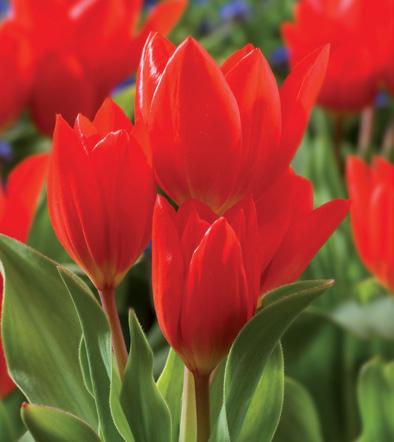
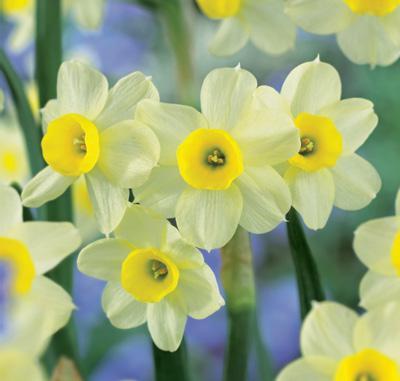
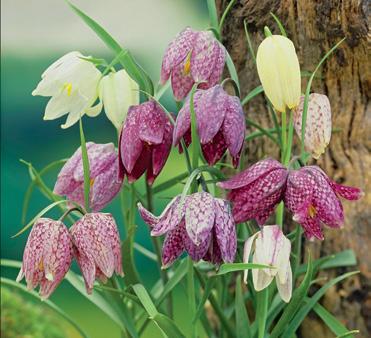
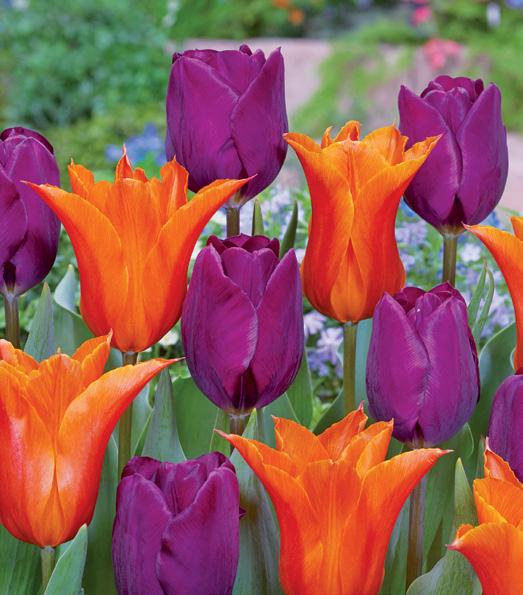
However, bulbs continue to be one of the most economical and self-sustaining ways to create a garden full of charm and interest, with so many varieties that can be planted to naturalise and spread of their own accord, forming carpets of colour year after year. Even the smallest garden can be enhanced by Anemone Nemerosa, Camassia, Chionodoxa, Cyclamen, Fritillaria Meleagris, Galanthus (Snowdrops), Hyacinthoides (True English Bluebells), Scilla and the naturalising varieties of mini Narcissi & Tulips. And planting these will greatly benefit bees, butterflies and many other pollinators at an important stage of their lives.
As you may know, we started selling Pictorial Meadows wild flower seed mixes about 15 years ago, and they have proved extremely popular. These have been developed at Sheffield University by Professors Nigel Dunnett and James Hitchmough, who were responsible for all the wonderful meadows at the Olympic Park. Initially they offered just annual mixes but now they have devised a range of perennial mixes, as shown on pages 70 & 71. We ourselves have sown their Persian Carpet mix at home with spectacular results. I could not recommend these mixes more highly, and if you have even the smallest area available in which to create your very own wild flower meadow, I would urge you to do so!
As we all know, the price of nearly everything continues to increase, and this unfortunately applies to all horticultural products, including bulbs – mainly due to energy, transport and paperwork costs. We have done our very best to absorb as many of these increases as we possibly can, and we endeavour always to provide best quality, top size bulbs which are genuinely ‘true to name’. I cannot emphasise too strongly the difference in performance that the larger sizes make.
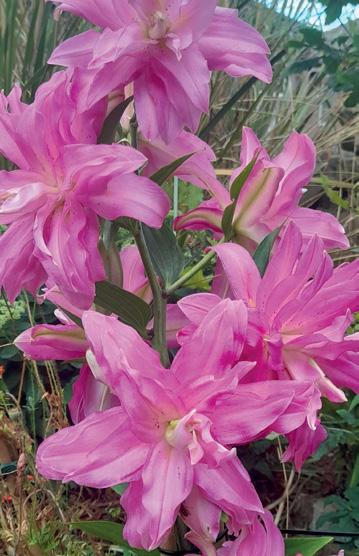
de Jager is now in its 155th year; the company has flourished by never compromising on quality, and this, together with our excellent customer service, has been appreciated by our loyal customers over many generations. It always gives us pleasure when customers go to the time and trouble of kindly sending us pictures of their de Jager bulbs - as with these beautiful Lilies and Narcissi. Please do keep sending your photographs in.
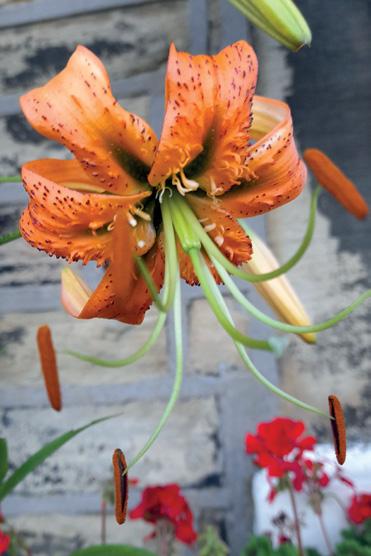
Charities have been very hard hit in the last few years, and we are delighted to continue our support for two of our favourites: Greenfingers and Horatio’s Garden. In the last few months, we have been able to send £3,500 to Greenfingers, who have so far built 50 gardens at children’s hospices up and down the country. We also regularly provide bulbs for Horatio’s Garden, who are in the process of creating their seventh garden for spinal injury patients at specialist clinics located throughout the UK. The benefits of gardens for health and well-being are very well known, and any help you could offer would be much appreciated by these two most worthwhile charities, which you can find at www.greenfingerscharity.org.uk and www.horatiosgarden.org.uk



Our website www.dejager.co.uk is continuously being upgraded to provide better navigation, clarity and compatibility with mobile devices. There you will find information on all our available products and the latest news and gardening tips. We continue to offer an online 10% discount for all retail web orders: just enter the voucher code WEB10 during the checkout process.
We always look forward to engaging with our growing online community, so do please follow us on:
Facebook Instagram Pinterest Twitter

Facebook: www.facebook.com/dejagerbulbs
Instagram: www.instagram.com/dejagerbulbs
Pinterest: www.pinterest.com/dejagerbulbs
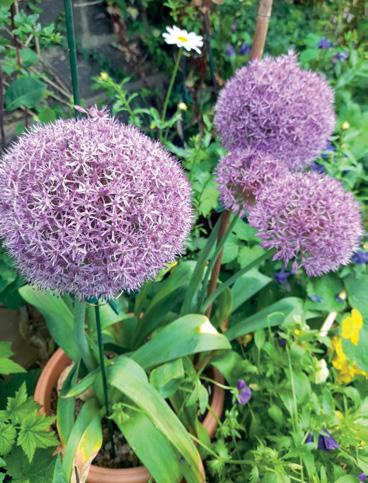
Twitter: www.twitter.com/dejagerbulbs
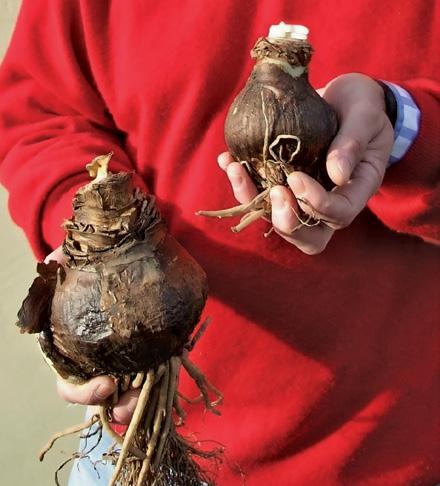
We trust that you will find our catalogue offers a comprehensive and exciting range of possibilities from which to create your new spring garden, and we are always happy to offer further assistance - please do not hesitate to get in touch if you have any queries.
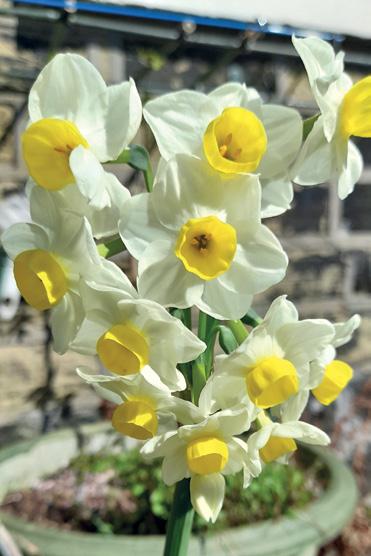
As usual the front cover of this catalogue features another fine illustration, this time of a wonderful display of the Fosteriana Four Colour Tulip Mix (pages 56 & 57) which we have specially commissioned from the up-and-coming botanical artist Alison Barter DipS.B.A(Dist).
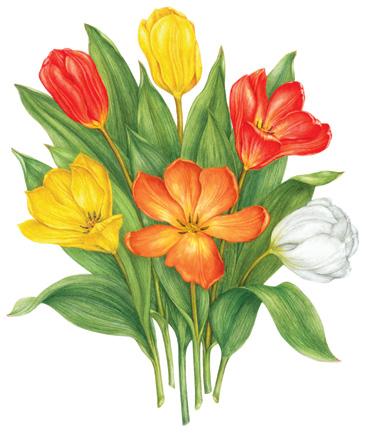
Yours sincerely,
George Clowes

FT = FLOWERING TIME, FH = FLOWERING HEIGHT, FD = FLOWER DIAMETER, BS = BULB SIZE.
SCENTED FLOWERS.
RHS PERFECT FOR POLLINATORS.
NEW OR REINTRODUCED.
RHS AWARD OF GARDEN MERIT.
Collections For Outdoor Pots And Tubs
Plant each variety in individual pots or, for a longer owering time, plant di erent varieties of bulbs in layers as illustrated above. Plant bulbs 1½ inches apart, larger bulbs at the bottom of the container with the smallest bulbs at the top, leaving 2 inches of soil between each layer. Space the bulbs alternately on each layer so they are not directly on top of one another. Varieties may vary slightly from the illustration but colours will not change.
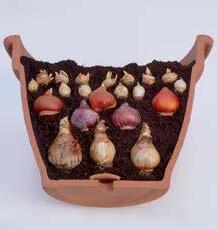
SOC15 The Blue and White Collection
SOC12 The Classic Collection
5 x White Tulips, 5 x White Multi owering Narcissus, 5 x White and Yellow Narcissus, 10 x Blue Scilla. For layered planting you will require a container 40 cm (16”) wide and 65 cm (25”) deep. BS: Top Size.
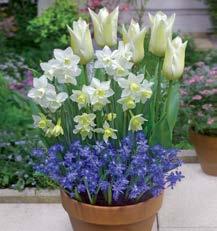
15 x Pink Tulips, 5 x Blue Hyacinths, 10 x Iris Reticulata and 10 x Chionodoxa White. For layered planting you will require a container 40 cm (16”) wide and 65 cm (25”) deep. BS: Top Size.
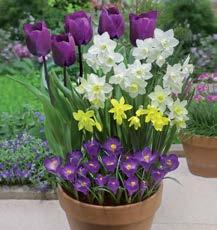
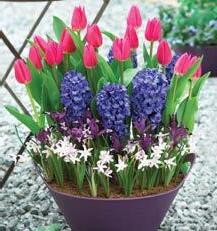
SOC16 The Mauve, White and Yellow Collection 5 x Mauve Tulips, 5 x White Narcissus, 5 x Yellow Narcissus and 10 x Mauve Crocus. BS: Top Size.
SOC11 The White Collection
SOC14 The Yellow Collection
6 x White Tulips, 6 x White Double Da odils, 3 x White Hyacinths and 15 x White Muscari. For layered planting you will require a container 40 cm (16”) wide and 65 cm (25”) deep. BS: Top Size.
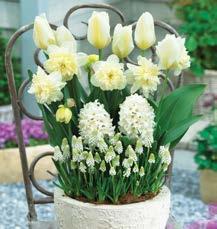
6 x Yellow Tulips, 6 x Yellow/Flamed Tulips, 6 x Yellow Narcissi, 6 x Yellow/ Orange Narcissi and 4 x Yellow Hyacinths. For layered planting you will require a container 45 cm (18”) wide and 65 cm (25”) deep. BS: Top Size.
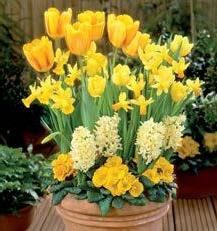
Per 1 8.75 Per 5 40.45
Per 1 8.75 Per 5 40.45
Per 1 5.70 Per 5 26.35
Per 1 9.55 Per 5 44.15
Per 1 8.60
Per 5 39.75
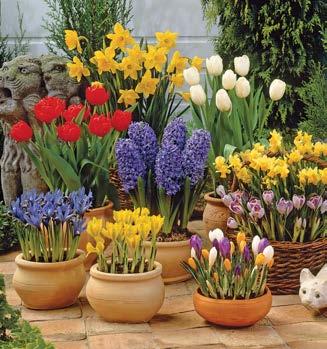
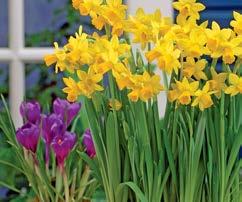
The Balcony And Patio Garden
If you only have a small garden or balcony you can still create a wonderful area. Select varieties from the page opposite or browse through the catalogue choosing varieties of your choice. Create a colourful area just outside your window to greet each morning as an inspiration for the day, and a herald of the warmer six months ahead.
M8024
M8025
6 x Allium Rosy Dream.
FT: May-July. FH: 40 cm (16”). BS: 6/+ cm.
10 x Anemone Blanda Blue.
FT: March-April. FH: 15 cm (6”). BS: 5/ cm.
10 x each of the best 7 varieties as chosen by de Jager.
FT:
10 x Mauve Dutch Crocus. FT: February-March. FH: 15 cm (6”). BS: 9/10 cm.
10 x Narcissus Tete-A-Tete.
FH: 15-20 cm (6-8”). BS: 14/16 cm.
80 bulbs in various varieties, packed separately.
10 x Yellow and Orange Narcissus.
FT:
FH: 25 cm (10”). BS: 12/14 cm.
COLLECTIONS FOR THE FLOWER BORDER Ideal for cut ower arrangements
The bulbs in these collections have been selected from our most popular varieties. They are ideal for planting in ower beds or containers and they also make excellent ower arrangements. The owering times, heights and colours for each variety will be as printed on each individual pack label. SFB11
SFB12
2 5 x Blue Hyacinth, 5 x Yellow and Orange Narcissus, 5 x Yellow Narcissus.
3 x Red Tulip, 5 x Narcissus Tete-a-Tete, 5 x Muscari Armeniacum Marlene, 5 x Yellow Dutch Crocus and 5 x Tulip Polycroma. x Muscari, 10 x Yellow and White Narcissus and 10 x Blue Chinodoxa.
Bulbs For Indoor Forcing
FORCING BULBS The bulbs on the next two pages are ideal for indoor planting. Once planted the pots need to be put in a cool, dark place, keeping the soil moist. Forcing will take between 12 and 16 weeks or when the shoots are 2’’ to 3’’ high. At this stage the pots should be brought out of cold storage into a cool unheated room. Turn the pots daily in order to keep the stems straight and strong. When the foliage and buds are well developed move the pots to a bright sunny position. This 2nd stage takes between 3 to 4 weeks.
CROCUS - LARGE-FLOWERING VARIETIES
The large Dutch varieties are best for forcing. Pickwick and Remembrance are all time favourites but all varieties on page 9 can be forced. Pot as above approximately 1’’ below the soil. These bulbs require about 12 weeks in cold storage.
C2243 Pickwick Silvery-white with deep and pale lilac stripes and a purple base. FT: February-March. FH: 15 cm (6”). BS: 9/10 cm.
C2245 Remembrance Producing an abundance of large amethyst-violet owers, with a silvery gloss. Very long-lasting. FT: February-March. FH: 15 cm (6”). BS: 9/10 cm.
Multiflowering Hyacinths
Multi ora Hyacinth bulbs are propagated so as to produce clusters of delightfully fragrant small owers. Each bulb will produce several slender stems on which the delicate bells are loosely set. They can be potted as above and are also ideal for naturalising in the garden.
each of the above varieties.
Prepared Christmas Hyacinths
These hyacinths are specially prepared for early forcing and for bowl and pot culture. When potting leave the tip of the bulb above soil level. Hyacinths need approximately 10 to 12 weeks in cold storage. They can also be forced in water sitting the bulb above water level so that the base of the bulb just touches the water, then place in the dark until the shoots are 2’’ to 3’’ high. Despatched from early September onwards when they are fully ready.
Iris Species
Follow the planting instructions on page 5. Plant 10 bulbs 1” deep in a 6” pot.
owers with golden-yellow central blotch. Scented.
MUSCARI (Grape Hyacinth) large deep cobalt-blue owers with a strong perfume.
Follow the planting instructions on page 5. Plant 15 bulbs 1’’ deep in a 6’’ pot.
Special Indoor Collections
The following collections have been selected from the prepared Hyacinths illustrated on the opposite page and 3 x Yellow Hyacinth.
HIPPEASTRUM (Amaryllis) Extra Large Bulbs
One of the top ten favourite house-plants. This size produces two stems carrying 3 to 5 blooms. Soak the roots and lower part of the bulb in tepid water for 24 hours. Once potted place near a radiator or re until there is 4’’ of growth, then move it to a sunny position. Always water at the top of the pot with tepid water.
M5537 Ambiance Large white owers with red stripes.
cm.
the most popular, pale pink and white owers with green centre.
white owers with a green throat.
HIPPEASTRUM (Small-Flowering)
A small- owered type producing up to 3 stems, each bearing 5 to 6 dainty owers.
bright red owers, perfect for the Christmas season.
INDOOR-FLOWERING NARCISSI
Follow the planting instructions on page 11. Plant so that the top half of the bulb shows above the soil line. Narcissi need 12 weeks in cold storage. Paperwhites and Grand Soleil d’Or can also be planted in pebbles with water up to the base of the bulb. To keep the water fresh add a small amount of charcoal. Place in a window and they will ower in 6 to 8 weeks. N0726 Bridal Crown Double creamy-white owers with yellow inner segments. Highly fragrant. Can also be planted in the garden. BS: 14/+ cm.
Chinese Sacred Lily Sweetly scented bunches of white owers with orange-yellow cups. Excellent for growing in pots. BS: 16/17 cm.
The fully double orets are ivory-white interspersed with primrose-yellow. Heavily scented. Ideal for pot culture. BS: 15/17 cm.
A very showy, deep yellow with deep brilliant orange cup. BS: 15/17 cm.
Trusses of pure white owers. Bulbs may be placed directly in the window after planting. The larger the bulb, the more owers per stem. Will ower 4 to 5 weeks after planting. BS: 17/+ cm.
N0673 Tete-a-Tete Bright yellow owers with paler yellow trumpet. 1-3 blooms per stem. One of the best all-round Narcissi ever. Superb naturaliser. BS: 14/+ cm.
COLCHICUM (Meadow Sa ron)
Colchicum are easy to grow, thriving in any well-drained soil in a sunny position. Excellent naturalisers, they will ower year after year and increase freely.
C2000 Autumnale A very free- owering purplish-pink. Valuable for naturalising.
FH: 10 cm (4”). BS: 13/+ cm.
C2007 Autumnale Alboplenum Spectacular large white double owers with several to each bulb.
October. FH: 10 cm (4”). BS: 13/+ cm.
C2013 Cilicicum Purpureum Beautiful rosy-purple owers.
FT: September-October. FH: 10-12 cm (4-5”). BS: 20/+ cm.
C2002 Giant Very large owers of beautiful form. Lightly tessellated lilac-purple petals with large white centre. Increases freely.
FT: September-October. FH: 15-20 cm (6-8”). BS: 20/24 cm.
C2010 Lilac Bedder Violet-mauve petals with a white throat, very vigorous growing variety, soon increases to form large clumps.
FT: October. FH: 15 cm (6”). BS: 18/+ cm.
C2006 Waterlily Large double rosy-lilac owers with segments opening horizontally to the sun. FT: September-October. FH: 12 cm (5”). BS: 14/+ cm.
Per 25 61.50
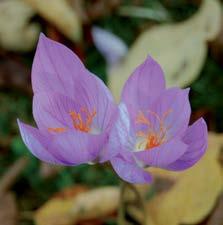
CROCUS (Autumn Flowering)
These unusual Croci bloom September-October. Excellent for naturalising.
purple owers with darker blue veining and orange anthers.
(The Sa ron Crocus). Large lilac owers with darker veins and brilliant red pistils. Requires plenty of sun to ower well, but owers freely once established. Likes rich soil and potash. FT: large owers of deep sky-blue with orange stigmata. Self seeding.
Beautiful upstanding bright lilac-blue goblets with dark violet veinings and vivid orange stigmata; seeds freely and its patches of blue are as pretty as those of English Bluebells.
A very hardy species with large, pale lilac owers with conspicuous darker veins and golden base. FT:
A magni cent white Crocus with large, impressive golden spots on the base.
A mixture of named varieties, consisting of species and hybrids in shades of blue and white. Excellent for naturalising.
STERNBERGIA (Lily of the Field)
C2111 Lutea Finest of all Sternbergias, with large bright yellow globular ower. Leaves do not appear until spring. Free- owering once established.
LARGE-FLOWERING DUTCH CROCUS
The following large- owering named varieties are some of the best in cultivation, very easy to grow and will ower and increase year after year.
deep purple owers.
golden-yellow owers produced in great abundance. Long-lasting.
A striking pure white, with large globular-shaped owers. Long-lasting and strongly recommended.
with deep and pale lilac stripes and a purple base.
an abundance of large amethyst-violet owers, with a silvery gloss. Very long-lasting. FT: blue owers, with greyish white outer petals and orange stamens.
Very early and rich owering, light mauvette shaded grey. Very attractive. Excellent forcer and long-lasting.
This mixture is made up from distinct varieties and is superior to other mixtures usually o ered.
Another stunning mixture of blue and white large- owering crocus which produces an enchanting e ect when planted in lawns etc.
C2251
Large-Flowering Blue Mixture - 3 Colours
C2255 Large-Flowering Yellow and White Mix
An enchanting and unusual mix of purple, violet and striped crocus. Rarely seen in any garden.
FT: February-March. FH: 15 cm (6”). BS: 9/10 cm.
A balanced mixture of yellow and white large- owering crocus. FT: February-March. FH: 15 cm (6”). BS: 9/10 cm.
When ordering, please quote catalogue code number, quantity required, variety name and price.
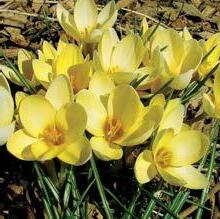
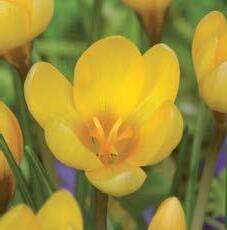
Sparkling Winter And Early Spring Flowering Crocus
The species, though smaller and a little earlier than the large- owering crocus, are just as colourful and ideal for naturalising.
(syn. Cloth of Gold). One of the oldest species known (1587). Brilliant deep orange-yellow prominently marked with mahogany veins.
A mass of pure white long-lasting owers.
Combination of yellow and bronze with lilac-mauve shadings on the outside and creamy-yellow inside, producing an abundance of large delicate owers.
Light lobelia-blue deepening to the bronzy-yellow base on the outside, inside lighter with a white margin and yellow centre.
creamy-white, exterior shading down to a pale brownish-lilac.
yellow owers with bronze feathering on outer petals.
petals entirely striped and feathered plum-purple on lemon-yellow ground. Very free- owering.
with deep yellow centre. Outer petals are feathered with rich plum purple.
owers with a large purple blotch in centre of each petal.
owers are white on the inside, and the three outer petals have an oval blue blotch.
inside of the ower is yellow and the outside creamy-yellow ushed apricot. A delightful combination. Extremely free- owering.
large orange stamens.
sapphire-lavender owers. The nest for naturalising. Seeds freely.
very striking ruby-purple with lighter base. Outstanding.
An unusual shade of reddish-purple not seen in any other crocus. Very freeowering.
Herald
This mixture is made up by ourselves and contains cream, gold, primrose, white, bronze, pastel-blue and mauve varieties. Ideal for early colour in the garden.
Exhibition Hyacinths
Unsurpassed for fragrance. Plant in beds, front of borders, window boxes or tubs. No garden should be without them.
25 cm (10”). BS: 18/19 cm.
FRAGRANT HYACINTHS (for Bowls & Bedding)
FT:
Double Hyacinths
Careful Shipping And Packing
We maintain a rigid system of inspection to see that each order is carefully assembled and packed to reach you in good condition.
For your convenience www.dejager.co.uk offers a wholesale section.
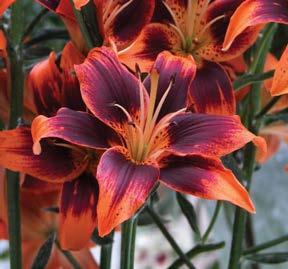
LILIUM CANDIDUM
Excellent plant for conservatory or outdoors close to a south wall.
L3000 The Madonna Lily
Has one of the most evocative of scents and the almost luminous satiny-white chalice-like owers seem to glow. Makes autumn top growth which overwinters. This Lily should be planted just below the surface. They may take a season or two to establish. FT: June. FH: 100 cm (39”). BS: 22/24 cm.
Lilium Asiatic Hybrids
Nothing compares to a mass of colourful lilies in full bloom. These regal carefree plants produce many owers per bulb, year after year with little or no extra care. Choose from a complete colour range of bright or pastel Asiatic lilies.
L3586 Blacklist Deep purple-black owers with orange stamens.
FH: 100 cm (39”). BS: 16/18 cm.
L3704 Elodie Double candy-pink petals with dark spots towards the centre.
FH: 50 cm (20”). BS: 16/18 cm.
L3031 Forever Susan Large owers of mahogany and orange facing outwards with lots of buds creating a tremendous display in early summer.
FH: 100 cm (39”). BS: 16/18 cm.
L3024 Patricia's Pride A stunning ower with gleaming white blooms brushed with midnight-purple. Outstanding. Excellent for cutting. FT: June-July. FH: 75 cm (30”). BS: 16/18
ASIATIC LILIES FOR POTS, TERRACES, PATIO & CONSERVATORY
Asiatic lilies are probably the most common and easily grown type of hybrid lily. They typically bear clusters of wide- aring owers atop strong stems. These shorter varieties are ideal for pots, terraces, patios and conservatories.
L3175 Foxtrot Pale pink with deeper pink veins and a pale lemon centre.
FH: 45 cm (18”). BS: 16/18 cm.
L3061 Happy Snow Snowy-white owers with dark stamens.
FH: 40 cm (16”). BS: 16/18 cm.
Lotus Lilies
This stunning new range of double Oriental Lilies produce blooms that have many petals resembling the Lotus ower. They are very long lasting and make wonderful cut owers. Highly scented.
L3800 Lotus Beauty White owers with a dusting of burgundy spots.
June-July. FH: 100 cm (39”). BS: 18/20 cm.
L3804 Lotus Dream Rosy-pink owers dotted with raspberry pink spots.
June-July. FH: 100 cm (39”). BS: 18/20 cm.
L3805 Lotus Queen Pale pink owers with a white centre and darker pink spots.
June-July. FH: 100 cm (39”). BS: 18/20 cm.
ORIENTAL LILIES FOR POTS, TERRACES, PATIO & CONSERVATORY
These compact Oriental lilies provide stunning displays for smaller areas, patios, conservatories and containers.
L3156 Garden Party
L4004 Salmon Party
Glorious large fragrant outward-facing white owers, with gold and either red or pink stripes in the centre of each petal. FT: July-August. FH: 45 cm (18”). BS: 16/18 cm.
Pale salmon petals with orange stripe and reddish spots. FT: July-August. FH: 55 cm (22”). BS: 16/18 cm.
LILIUM ORIENTAL HYBRIDS (All are fragrant)
Over the past few years the demand and interest in Oriental Lilies has grown dramatically. Hand in hand with this, the hybridizers in Holland have been turning out many new and interesting Orientals. If you are a lily lover, we know that you will enjoy them.
L3086 Casa Blanca
L3109 Josephine
L3099 Stargazer
Very large waxy pure white owers, up to 25 cm (9”) wide. Unspotted; pollen orange-brown. Very attractive.
FT: July-August. FH: 90 cm (36”). BS: 18/20 cm.
A beautiful light pink with darker bands of candy pink blending with an icy pinkwhite nectary and light speckles. Sweetly fragrant.
FT: July-August. FH: 90-120 cm (36-48”). BS: 18/20 cm.
A true favourite having dramatic upright rich crimson-red owers edged white and generously spotted maroon. One of the nest lilies for containers and for forcing. FT: July-August. FH: 90 cm (36”). BS: 18/20 cm.
L3872 Virtuosa Pale pink owers with a white centre and deep pink spots.
FT: July-August. FH: 100 cm (39”). BS: 18/20 cm
Lilium Martagon Varieties
These statuesque lilies produce numerous scented owers with up to 50 on vigorous plants.
L3386 Arabian Knight Red and gold owers with pale gold stamens.
FH: 80 cm (32”). BS: 14/16 cm.
L3379 Claude Shride Dark mahogany-red with golden-yellow speckles.
FH: 80 cm (32”). BS: 14/16 cm.
L3392 Guinea Gold Yellow with deep orange spots.
L3398 Peppard Gold The pink buds open to golden-yellow owers.
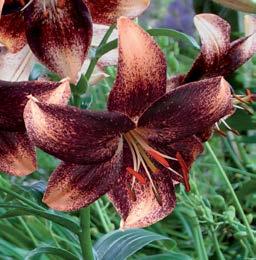
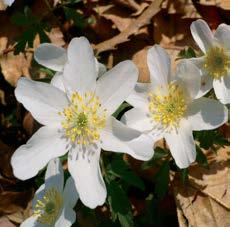
Lilium Species Turkish Cap
A very ne species of lilies with Turk’s cap shaped blooms having down-facing owers with recurved petals on tall upright stems.
L3361 Black Beauty
L3363 Henryi
Tiger Lilies
Deep claret-red with a green star in centre. The star is outlined in white, as are the petal edges. When established this will produce as many as 40 or more owers. FT: July-August. FH: 125 cm (49”). BS: 16/18 cm.
Extremely hardy, vigorous and very free- owering, bearing up to 30 large, gracefullypoised, nodding owers of rich, deep orange-yellow with prominent green central line, for which the purple-black stem and glossy deep green foliage act as a perfect foil. Prefers a lime-rich soil. FT: August. FH: 120 cm (48”). BS: 16/18 cm.
Tiger lilies are invaluable border plants, long-lasting and of easy culture. Their imposing spikes of richly coloured Turk’s Cap owers are exceedingly e ective.
L3859 Chocolate Event Burgundy owers blending to a peachy-orange colour.
FT: July-August. FH: 110 cm (44”). BS: 16/18 cm.
An outstanding garden variety. Slightly re exing orets of oenothera yellow, evenly spotted chocolate-brown except for the tips.
velvety, deep red owers. Rich and highly attractive.
LILIUM TRUMPET-SHAPED HYBRIDS
Statuesque, impressive and vigorous varieties.
Anemone
with yellow glow in throat. Highly scented.
Culture: any good soil, moderately well-drained. Plant 10-15 cm (4-6”) apart, 5-8 cm (2-3”) deep. Steep in water for 10 hours before planting. (Top Size Corms).
admired for its ne shades of blue owers. Very free- owering.
magni cent variety producing dark pink owers on strong stems.
We strongly recommend Anemone Blanda. Dainty owers of blue, pink and white. FT: March-April.
single pure white owers.
owers with striking black stamens. A show-stopper.
An outstanding strain known as ‘Poppy Anemones’, colours ranging from white to deepish blue by way of pink, red and purple.
M5104 Nemorosa
M5115 Nemerosa Robinsoniana
The white ‘Wood Anemone’ is tinged pink. It makes a splendid carpet under trees and shrubs. Likes cool shade and soil enriched with leafmould. Will ower year after year. Plant rhizomes just beneath the surface. FT: March-April. FH: 15 cm (6”). BS: Top Size.
Highly attractive bright lavender-blue with dark green foliage tinged purple.
FT: May-June. FH: 25-30 cm (10-12”). BS: Top Size.
M5105 Nemorosa Vestal Superb double white owers with central buttons of symmetrically arranged sepals. FT: March-April. FH: 15 cm (6”). BS: Top Size.
M5106 Ranunculoides Deep buttercup-yellow owers with green shaded purple leaves, grows well in damp soil in the shade of trees. FT: March-April. FH: 15 cm (6”). BS: Top Size.
M5100 St. Brigid Mix Flowers are semi-double with nurmerous segments arranged in three or more layers around the centre. FT: May. FH: 25-30 cm (10-12”). BS: 8/+ cm.
Per 5 9.00 Per 25 41.65
Per 5 7.60 Per 25 35.15
Per 20 11.40 Per 100 52.75
Per 20 6.45 Per 100 29.85
When considering lilies in your garden, the rst and most important factor to bear in mind is that they must have good drainage. Soil which remains waterlogged after rain is not suitable and will almost certainly mean an early death for any lily planted in it.
Allium
Alliums are very versatile bulbs. Not only are they decorative in the garden, they are also rewarding subjects for ower arrangers.
beautiful species with a dense umbel of purple-lilac owers. Excellent for drying.
owers with narrow green leaves.
compressed umbel of lovely deep red-purple owers.
Fine small compact heads of deep ax-blue owers.
with numerous green-yellow owers. Ideal for cutting.
Flowers freely in June, bearing large heads, up to 25 cm (10”), of star-shaped amethyst-violet owers with a metallic sheen.
heads of pure white owers. Extra ne for cutting.
amethyst purple. This variety is a cross between Atropurpureum and Christophii. FT: June. FH: 80 cm (32”). BS: 8/+ cm.
wonderfully distinctive Allium, bearing dense umbels of up to 30 glistening yellow bell-shaped owers.
BS: Top Size.
impressive variety bearing large heads of violet owers up to 15 cm (6”) across.
cm (42”). BS: 20/+ cm.
large head of lilac-purple owers. Strong grower.
stately plant has enormous heads of aster-violet. Leaves are glossy green.
with purple stamens.
globular heads of light purple-pink with purple mid-veins, large at reddish green leaves with red margins.
semi-round blooms have open spiky ower heads.
golden-yellow star-shaped owers. Two ower stems per bulb.
of creamy-white, spiky star-shaped owers.
cm (5-6”) across of pure white owers with green stamens. FT: some open ower heads. A cross between Purple superb variety with large dense heads of 50 or more star-shaped deep purple owers. Excellent cut owers. wine-red heads with a unique tuft at the top tipped with tiny white owers. FT: purple-pink owers ideal for ower arranging. The bulbs rapidly grow into large clumps. FT: June-July. FH: 35 cm beautiful species with big heads of bright mallow-purple tubular owers on long pedicels. heads resembling a rework. Long lasting. purple owers with a creamy-white edge to each oret. heads of widely spaced starry lilac-rose owers. Cross between Atropurpureum and Schubertii. of Purple Sensation and Mount Everest.
Multibulbosum). Very ne semi-rounded heads of whitish owers, accentuated by a green centre.
Bulbs can be poisonous if eaten. In particular, please take care to keep toddlers away from Arum lilies and Convallaria (Lily-of-the-Valley).
Catalogue Index is on Page 72.
BS: Top Size.
Flower). An interesting plant producing egg-shaped compact heads of purple-crimson owers. Striking in border.
AMARYLLIS
Require a sheltered well-drained position. Plant these large Top Size bulbs just below the surface 30 cm (12”) apart.
M5081 Belladonna (The Jersey Lily). Fine deep pink owers in elegant umbels. The owers carry a delicate spicy perfume. FT: September-October. FH: 80 cm (32”). BS: 20/22 cm.
ARUM
Per 3 10.25 Per 15 47.40
Plant 15 cm (6”) deep in well-drained, humus-rich soil in sun or light shade. Spacing 10 cm (4”) apart. Excellent for naturalising.
M5161 Italicum
BELLEVALIA
Known as ‘Lords and Ladies’. Large waxy marbled leaves throughout winter, with greenish-white ower spathes appearing in spring followed by brilliant orangered berries in the autumn. The berries must not be eaten.
FT: Spring and Summer. FH: 25 cm (10”). BS: 8/10 cm.
A striking genus of the Hyacinthacea family showing the best of blue shades. Easy to cultivate and frost hardy.
M5174 Pycnantha
Calochortus
Cone-shaped navy blue owers.
FT: April-May. FH: 25-30 cm (10-12”). BS: 6/+ cm.
Likes a sunny, sheltered well-drained position in the garden. Often called ‘Fairy Lanterns’.
M5198 Cupido
Named after a species of butter y, these pretty little plants produce violet-pink cup-shaped owers.
FT: June. FH: 30 cm (12”). BS: 4/+ cm.
The Lure Of The Little
Per 50 10.45 Per 250 48.35
Per 50 7.10 Per 250 32.85
Most gardeners are familiar with the more common small bulbs such as Croci, Snowdrops, Muscari and Scillas. But there are many other delightful small- owering bulbs which are overlooked: we suggest miniature Narcissi, Species Tulips, Chionodoxa, Eranthis, Fritillaria Meleagris and Iris Reticulata.
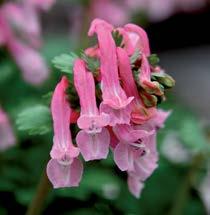
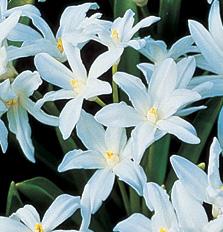
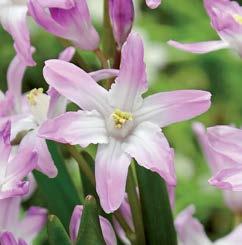
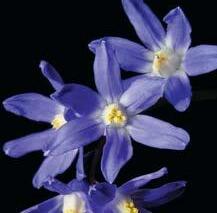
CAMASSIA (The Quamash)
Handsome plants for the border or naturalising. Like a moisture-retentive soil.
Large spikes of pale blue star-shaped owers.
Deep blue owers with variegated leaves. Excellent for naturalising.
wisteria-blue star-shaped owers with pale golden anthers which rise from a rosette of broad glaucous foliage.
Fine creamy-white star-like owers tightly set on a long strong stem.
Beautiful intense sky blue spikes.
spikes of deep mauve-blue owers. One of the nest.
bright blue owers.
(syn. Esculenta). Graceful rich blue owers; should be planted in groups in the border or naturalised in woodlands etc. Very striking.
Corydalis
Corydalis are rewarding little plants, for they invariably do well in shady unpromising positions, bringing colour to the bleakest corners of the rockery and garden. Plant 8-10 cm (3-4”) deep.
A compact plant bearing light mallow-purple owers. Excellent for naturalising.
owers with some white on the spur. Recommended.
CHIONODOXA (Glory of the Snow)
Chionodoxa is one of the earliest spring owers. Spreads quickly.
rich violet form. Popular naturaliser. mix of pink, white, blue and violet varieties.
No rock garden should be without them.
CYCLAMEN (Hardy)
They prefer shallow planting and a well-drained rich soil. Supplied in 9 cm pots.
M5261 Coum Dark green foliage with variable pink owers. Seeds freely.
M5262 Coum Album
FT: January-March. FH: 8 cm (3”). BS: 9 cm pots.
Beautiful dark green kidney-shaped foliage shows o to perfection the numerous white owers with crimson-magenta blotches.
FT: January-March. FH: 8 cm (3”). BS: 9 cm pots.
M5263 Hederifolium (syn. Neapolitanum). Producing an abundance of rosy-pink owers with dark eyes in autumn, before the large nely-marked variegated leaves appear. Seeds freely. FT: Autumn. FH: 12 cm (5”). BS: 9 cm pots.
M5264 Hederifolium Album A pure white form of the above.
FT: Autumn. FH: 12 cm (5”). BS: 9 cm pots.
M5265 Mirabile
Dainty slender owers of pale to deep pink, serrated at the edges and with a magenta blotch at the base of each lobe, are produced with the heart-shaped leaves in autumn.
BS: 9 cm pots.
Pure white owers. Green leaves with silver speckles.
Deep carmine-pink owers with chocolate-magenta ‘ace of spades’ shaped blotch towards base of each lobe. Leaf dark green with grey-green or whitish marbling. Scented.
9 cm pots.
Dichelostemma
An unusual plant producing umbels of tubular owers on strong stems. Prefers a sheltered sunny spot in well-drained soil.
purple owers with 3 white corona projections.
Bright red orets with greenish-yellow tips. Likes a sunny position.
M5291
M5292 Pink Diamond Lilac-rose tubular owers with white starry tips.
ERANTHIS (Winter Aconite)
Once established, Aconites spread by self-seeding, forming thickly populated colonies. They are happy in any well-drained soil; best position is under deciduous trees and shrubs where the low angled winter sun can penetrate beneath the branches. The small tubers should be planted 4 cm (1.5’’) deep, 5-7 cm (2-3’’) apart.
M5301 Cilicica Deep yellow, bronzy foliage, more nely cut than E. Hyemalis, also blooms later. Will seed freely. FT: January-February. FH: 5 cm (2”). BS: 5+ cm.
M5302 Hyemalis
The buttercup-yellow owers are set in rosettes of deep green leaves. They don’t mind the frost or snow. Will seed freely.
FT: January-February. FH: 8 cm (3”). BS: 4/5 cm.
EREMURUS (Fox Tail Lily)
The aristocrats of garden plants, they sometimes need one or two seasons to settle down before owering. They prefer light soil and full sun is essential. Feed well.
M5311 Cleopatra (Ruiter Hybrid). Very large orange-rose. Outstanding.
FT: June-July. FH: 120 cm (48”). BS: Top Size.
M5326 Emmy Ro Tall spikes of small pale orange buds opening to golden-yellow owers.
FT: June-July. FH: 125 cm (49”). BS: Top Size.
spikes of large snow-white owers.
150 cm (60”). BS: Top size.
stately spikes of apricot-pink owers.
M5327 Macarena of pink owers like gigantic candles. Ideal for back border. of owers in a wide range of beautiful shades varying from white to yellow, bronze, orange, pink or salmon-pink.
FT: June-July. FH: 130 cm (50”). BS: Top Size.
M5313 Pinokkio (Ruiter Hybrid). Magni cent elegant trusses of glowing orange.
For larger quantities please telephone 01622 840229 for prices.
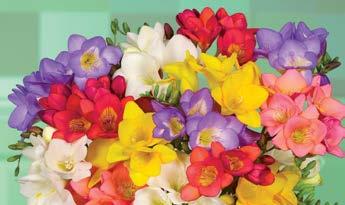
ERYTHRONIUM (Dog’s Tooth Violet)
Graceful spring- owering bulbs that multiply freely. Discovered in 1596. Thrive best in a moisture-retentive, yet well-drained porous soil; plant 8 cm (3’’) deep, 10 cm (4’’) apart.
M5341 Dens Canis Lilac Wonder owers of lilac-pink with chocolate-brown basal spot. owers with heavily mottled leaves.
FH: 10 cm (4”). BS: Top Size.
FREESIA
Canis pure white owers, mottled leaves. shades of lilac, pink, purple and white. robust hybrid bearing 4 to 5 Dresden-yellow owers, ringed brown in centre. Fast increaser and naturaliser. Leaves are lightly mottled.
Queen A splendid early- owering variety. Large re ned blooms are a delicate shade of clear pink. FT: March-April. FH: 12 cm (5”). BS: Top Size.
FH: 12 cm (5”). BS: Top Size.
One of the most beautiful, often bearing two exquisite snow-white owers on a stem. Re exing petals, cream anthers and chocolate-zoned centre. Richly coloured foliage. FT: March-April. FH: 20 cm (8”). BS: Top Size.
Grow under glass in loam-based potting soil with added grit. Shade from sun and keep moist until established, then grow in full light with good ventilation and water freely. Keep temperature approximately 55oF. Once ower buds appear, feed weekly with a balanced liquid fertiliser. (Corms).
FREESIA DOUBLE
M5371 Double Freesia
FREESIA SINGLE M5372
A truly ne mixture of double and semi-double hybrids. Strong stems.
A delightful mixture made up of many lovely shades, sweetly scented.
Fritillaria Imperialis
Plant 15 cm (6’’) deep, rmly in rich well-drained soil. Failing to ower after the rst year is due to a lack of potash fertilizer, essential for spurring bloom formation for the following year’s owering.
ne and stately Crown Imperial with large orange-red owers.
large golden-yellow owers.
large ame-orange variety. Sturdy stems bearing owers of dark bronzy-red.
FRITILLARIA MELEAGRIS (Plover’s Egg or Snake’s Head)
Naturalise in grass, shady glens or under large trees.
M5402 Meleagris Alba This is the lovely white form of the well-known ‘Snake’s Head’ fritillaria. Strong grower. FT: April-May. FH: 20 cm (8”). BS: 6/+ cm.
M5401 Meleagris Mixed Flowers of varying shades of white, purple and maroon. Beautifully chequered.
Fritillaria Persica
petals edged with pale green.
border plant. It is a creamy-white form of the above.
vigorous with dark plum-purple bell-shaped owers on plain green stems.
and outstanding.
with up to thirty blooms on tall strong stems
FRITILLARIA SPECIES (Top Size Bulbs)
marked with reddish-brown.
nodding owers of purple-black striped with olive green.
stem. Inside shiny yellow, outside purplish-brown, edged nodding creamy-yellow bell-shaped owers which are sometimes marked with faint reddish tessellations.
Wonderful greenish-yellow owers with a touch of burgundy.
Outside purplish-grey, edged yellow. Leaves shiny green. Outstanding.
GALANTHUS (Snowdrop)
Snowdrop corms should be planted about 5 cm (2’’) deep and 8-10 cm (3-4”) apart. If the clumps become too thick they can be lifted and divided immediately after owering and before the foliage has died down.
Single Snowdrop with large snowy white globular owers, the inner segments marked with emerald-green.
Pure white owers with silvery-green foliage.
Large white owers with a green base and grey-green leaves.
The common Single Snowdrop is a favourite to greet the New Year. Plant in sun or shade.
FT: January-February. FH: 15 cm (6”). BS: 6/+ cm.
M5443 Nivalis Flore Pleno (Double Snowdrop). Large globular bloom of peerless white with a touch of green inside.
M5444 Nivalis Viridapice
M5446 Sam Arnott
FT: January-February. FH: 15 cm (6”). BS: 5/+ cm.
Large globular-shaped single ower which has a distinct blotch of green at the tip of the outer petals. A robust grower. FT: January-February. FH: 15 cm (6”). BS: 5/+ cm.
Rounded single owers with a very deep green heart-shaped marking. Highly scented.
FT: February-March. FH: 10-15 cm (4-6”). BS: 6/+ cm.
M5445 Woronowii (syn. G. Ikariae). Elegant globular snow-white single owers, the inner segments marked with green. Leaves bright green and glossy. FT: January-February. FH: 15-20 cm (6-8”). BS: 6/7 cm.
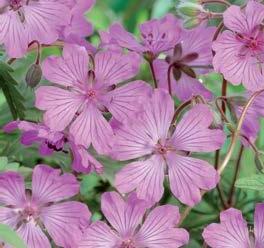
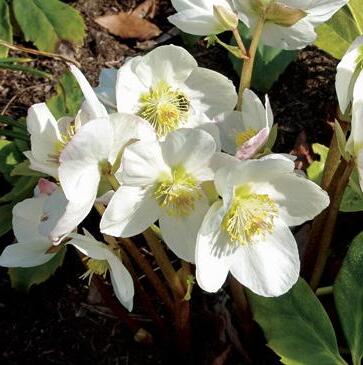
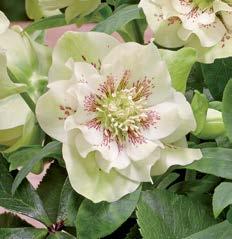
Geranium
Ideal for front of border. If left undisturbed they will naturalise. Plant in any well-drained soil 5 cm (2’’) apart.
M7250 Tuberosum A mass of tiny pink and white owers.
FT: April-May. FH: 20-25 cm (6-10”). BS: 5/+ cm.
Gynandriris
M5465 Sisyrinchium Bright violet-blue owers with slender dark green leaves.
Hardy Gladiolus
These early- owering Gladioli are similar in form to the large- owering type, but hardy.
red petals with a white edge.
FH: 75 cm (30”). BS: 10/+ cm.
owers with purple lips.
of white funnel-shaped owers with purple anthers.
brilliant deep purple-red owers are freely produced and often shaded with a tinge of reddish-violet. FT: June. FH: 60 cm (24”). BS: 6/+ cm.
owers, with slightly ru ed orange-red edges.
Helleborus
owers of azalea-pink, phlox-pink in throat, lower petals phlox-pink with cardinal-red centre. FT: the most beautiful. The owers are whitish-pink with cream coloured blotches, edged china-rose. FT: owers in a variety of pink shades, with leathery deep green leaves.
Likes deep, well-composted, rich soil. Shade or semi-shade preferred. Supplied in 9 cm pots.
M5503 Niger Treasured for its wide-petalled winter blooms – white, blushed pink on the reverse, with ne golden stamens.
HERMODACTYLUS (The Snakeshead Iris)
M5471 Tuberosa
A distinct and interesting species in cultivation since 1575, often known as ‘The Snakeshead Iris’ or ‘Widow Iris’. The fairly large erect owers are of a peculiar olive-green shade, with dark almost black velvety purple falls, occasionally streaked with yellow or bright green.
FT: April-May. FH: 25-30 cm (10-12”). BS: Top Size.
HYACINTHOIDES (True British Bluebells)
This group of bulbs is o cially classi ed as Hyacinthoides and no longer Scilla. Perfect for naturalising in woodlands or other cool semi-shaded sites.
M5551 Non Scripta
IPHEION (Triteleia)
(English Bluebell). Graceful arching stems with clusters of purple-blue bellshaped owers. The true English Bluebell, a must for woodland and wild planting. Seeds freely and colonies are soon formed.
FT: April-May. FH: 25-30 cm (10-12”). BS: 6/+ cm.
Excellent for rockery or front of border. Plant 3-5 cm (1-2’’) deep in well-drained soil.
white owers in abundance.
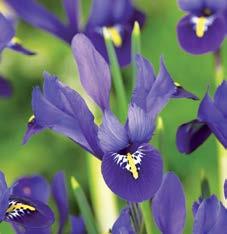
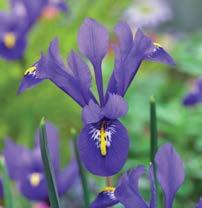
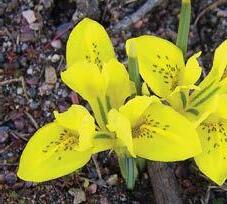
IRIS SPECIES & HYBRIDS
The lovely dwarf iris provides a welcome splash of colour in the garden. Best in sunny, well-drained position.
splendid plant with light blue owers.
with yellow blotch on the falls.
owers with straw-coloured tips to the outer segments.
with blue and white markings.
yellow owers shading into greenish-yellow at the base of the segments, with small brown spots. Scented.
owers with a central yellow band and splashes of white.
yellow and white owers.
large ower, standards bluish-green, veins greenish-blue; falls yellowishgreen, blotch yellow edged green, veins slate-blue. Outstanding.
owers with golden-yellow central blotch; a gem to naturalise in borders and rock gardens. Scented.
owers have a white blotch with a hint of yellow.
and royal-blue falls with white-edged yellow blotches.
elegant ivory-white almost ice-blue falls. Highly popular variety.
IRIS (I. Stylosa)
cream owers with yellow throat and deep yellow stripe.
have white falls with deep purple tips and purple spots.
blue with deep blue and yellow markings.
mixture of Harmony and Alida varieties.
A splendid mixture of this section, colours ranging from pale blue to reddishpurple, all with very attractive di erently coloured marked falls.
English Iris
The ‘Winter Flowering Iris’. Requires a light soil and south-facing spot. Sweetly scented lavender-blue owers are produced in abundance. October delivery.
FH: 35 cm (14”).
Top Size.
This magni cent Iris, which blooms later than the Dutch Iris, is more robust. June-July owering.
blooms.
Never store bulbs in a warm or damp area prior to planting. Keep them in cool, dry conditions.
Dutch Iris
Dutch Irises are valuable garden plants and ower year after year, having long-lasting qualities.
with golden-yellow falls.
white owers with delicate blue veins and a yellow blotch.
with golden-orange blotch on the falls.
with bronze falls and a yellow blotch.
with a yellow-orange blotch on the falls.
superb variety. Standards white with violet gloss, falls ivory-white with golden yellow blotch.
yellow and white mix.
mixture to those usually o ered, made up from the best named varieties.
IXIA (African Corn Lily)
Plant 7 cm (3’’) deep and about 7 cm (3’’) apart in a sandy loam where they can be left undisturbed. Also suitable for a cool greenhouse or conservatory.
owers, tipped purple with dark centres.
deep pink.
Ixiolirion
blooms with darker centres. Glorious.
owers with deep wine-coloured eyes. A stunner.
great variety of brilliant colours. Excellent for cutting.
Graceful funnel-shaped owers, ideal for rockeries, borders and naturalising. Look best planted in clumps.
blue with strong slender stems. Ideal for ower arranging.
LEUCOJUM (Snow ake)
A family of attractive plants resembling the Snowdrop but much larger. They do best in moist conditions.
White with green tips.
Gravetye Giant Producing heads of large drooping bells of white tipped green. Good naturalised in grass. Very robust. FT: April-May. FH: 45 cm (18”). BS: 14/+ cm.
Vernum (Spring Bells). Dainty little bell-shaped owers of pure white, beautifully tipped with green or yellow markings.
Careful Shipping And Packing
We maintain a rigid system of inspection to see that each order is carefully assembled and packed to reach you in good condition.
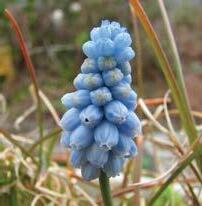
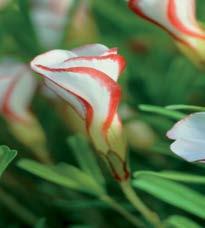
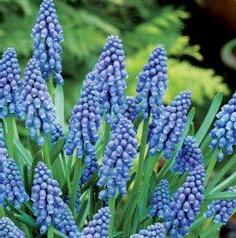
MUSCARI (Grape Hyacinth)
Easy to grow. Plant about 8 cm (3’’) deep and 5-8 cm (2-3’’) apart; once planted can be left to multiply.
Very large deep cobalt-blue owers with a strong perfume, excellent for naturalising. FT: April-May. FH: 10-20
Very distinctive blue owers, a long-lasting variety.
The rst white cultivar of the grape hyacinth which is suitable for use in pots. Sturdy short leaves show o the lovely clusters of pure white owers. Vigorous and long-lasting. FT: magical blue and white carpet. distinct, light blue buds above dark blue owers on strong stems, with one single broad leaf.
Bearing pretty fragrant pure white owers.
Nectaroscordum
bearing pretty, clear, porcelain-blue
Previously listed in the Allium group. Ideal for naturalising, as they grow in sun or shade and all soils.
M5761 Siculum
ORNITHOGALUM of
Large blue-green, broad bell-shaped ower, broadly striped with dark brownred on the outside, borne on long curving pedicels in large loose umbels of up to 30 owers. FT: May-June. FH: 85 cm (33”). BS: 10/+ cm.
Suitable for naturalising in shrubberies, grassy banks or in the border.
Lovely green and white satin-like owers with 10 to 20 per stem.
OXALIS (Wood Sorrel)
Pure white starry owers, hardy, ne for massing and edgings.
Lovely little plants for borders and rockery. They are also excellent as pot plants.
of carmine-pink with fern-green lea ets with a cross-shaped dark purple blotch. FT: April-June. FH: 8 cm (3”). BS: 5/+ cm.
M5784
M5786 remarkable species with foliage of wine-red and purple-maroon and rose owers. FT: Summer owering. FH: 15 cm (6”). BS: Top Size.
White funnel-shaped owers with a raspberry-red edge.
October-November. FH: 10-20 cm (4-8”). BS: Top Size.
M5792 Versicolor Golden Cape Golden-yellow owers, petals edged with a red stripe. Flowers open during the day and close at night. FT: August-October. FH: 10-20 cm (4-8”). BS: Top Size.
Puschkinia
This dainty Scilla-like plant is most suitable to grow in clumps in a sunny rockery or planted in drifts.
M5812 Alba Glorious white owers.
FT: March-April. FH: 10-15 cm (4-6”). BS: 6/+ cm.
M5811 Libanotica (The Striped Squill). The dainty stems bear clusters of pale blue owers with a deeper blue streak down the centre of the petals.
FT: March-April. FH: 12 cm (5”). BS: 6/+ cm.
Ranunculus
Excellent for cutting. Plant 7-10 cm (3-4”) deep, claws down in a sunny location with well-drained soil.
of yellow, bronze and orange.
SCILLA (Squill)
Attractive when planted in drifts; being dwarf and compact they are also e ective in borders. Excellent naturalisers, they like humus-rich soil.
little heads of deep blue owers. Excellent naturaliser.
light blue, bell-shaped owers are quick to naturalise, forming a carpet pure white owers, an excellent variety for naturalising. succession of larger striking bright blue owers. Very robust.
BS: 8/+ cm.
SPARAXIS (Harlequin Flower)
Plant in a light sunny position in well-drained soil and protect from severe frosts during winter. Long-lasting. Fine cut ower.
well-balanced mixture of a wide selection of brilliant colours.
Triteleia
A graceful plant which can also be used for cut owers. Plant in a sunny, well-drained position.
M5859 Foxy Snowy-white owers with violet blue stripes.
FT: July. FH: 30 cm (18”). BS: 5/+ cm.
M5870 Laxa Corrina Deep purplish-blue star-shaped owers, long-lasting as cut owers.
FT: June-July. FH: 50-60 cm (20-24”). BS: 6/+ cm.
M5861 Queen Fabiola Producing clusters of attractive light violet-blue owers. Long-lasting. FT: July. FH: 50-60 cm (20-24”). BS: 6/+ cm.
M5866 Silver Queen Upward facing white bell-shaped owers on strong stems. Excellent cut owers. FT: July. FH: 45-50 cm (18-20”). BS: 5/+ cm.
ZANTEDESCHIA (Arum Lily)
Plant in a sunny well-drained position. M5871
Waxy pure white trumpet-shaped spathes, 10-15 cm (4-6’’) across. Long-lasting cut owers. FT: June-July. FH: 60-80 cm (24-32”). BS:16/18 cm.
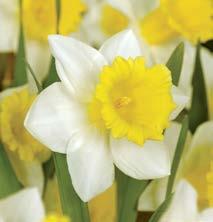
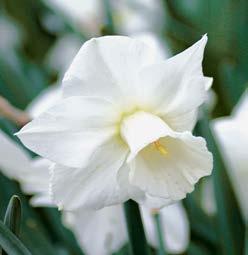
Mixtures Of Daffodils And Narcissi
Varieties used in the following mixtures may vary from those pictured, but colour schemes will be the same.
N0785 Botanical Mix
N0771 Double Daffodil Super Mixture
N0772 Flower Border Mixture
N0777 Miniature Narcissus Mixture even mixture of yellow and white Cheerfulness. mix of the Thalia and Sunlight Sensation. spectacular mixture of the nest trumpet da odils including yellows, whites and bicolours. FT: March-April. FH: 35-45 cm (14-18”).
A well-balanced mixture of yellow, and yellow and white miniature varieties. Ideal for the rockery or the front of ower borders.
FT: March-April. FH: 15 cm (6”). BS: 8-12/+ cm.
This excellent well-balanced mixture will appeal to all, specially made up by ourselves from distinct varieties. Ideal for naturalising and ower arrangements. FT: March-April. FH: 15-45 cm (6-18”). BS: 12/16 cm.
This mixture is specially made up by us from named varieties and is greatly superior to the cheap mixtures frequently sold. Every bulb has been carefully chosen to give interesting variations in height and form over a long owering period. It is therefore particularly suitable for planting in large clumps in your shrubbery or herbaceous borders where the bulbs can be left for many years.
FT: March-April. FH: 40-45 cm (16-18”). BS: 12/16 cm.
The Narcissi in this mixture may be small but they will provide a long season of wonderful blooms. FT: March-April. FH: 25-30 cm (10-12”). BS: 10/14 cm.
A stunning mix of varieties with ivory to white petals and pink, salmon or apricot cups. FT: March-April. FH: 35-45 cm (12-18”). BS: 10/14 cm.
This delightful mixture will appeal to all, specially created by ourselves from distinct varieties, many of which are deliciously fragrant.
This mixture includes Yellow and White Trumpets in proper proportions selected to provide a stunning display over a long period.
A well-balanced mixture superior to mixtures usually sold elsewhere. A mix of all types of Da odils and Narcissi for naturalising. The bulbs o ered as lifted, which means they are not graded but are all of owering size.
N0776 25 kg (approx. 350-400 bulbs)
Division 1
A well-balanced mixture superior to mixtures usually sold elsewhere. A mix of all types of Da odils and Narcissi for naturalising. The bulbs o ered as lifted which means they are not graded, but are all of owering size. FT: March-April. FH: 30-45 cm (12-18”). BS: 10/12 cm up to 14/16 cm as lifted.
Large Trumpet Daffodils
N0097 British Gamble
N0156 Desdemona
N0102 Dutch Master
N0109 Las Vegas
N0108 Marieke
Large white perianth, the pale lemon trumpet has an apricot-pink frilled edge. FT: February. FH: 40 cm (16”). BS: 14/16 cm.
The ne perianth stands at right angles to the lovely white cup which is almost trumpet length and slightly ared at the mouth. The owers have a satin-smooth texture and are nicely poised with good upright foliage. Winner at da odil shows.
FH: 35 cm (14”). BS: 14/16 cm.
Rich golden-yellow, broad overlapping perianth with a deeply serrated large trumpet. Strong stems. FT: March. FH: 40 cm (16”). BS: 14/16 cm.
Ivory-white with a vivid yellow cup. Large owers on sturdy stems. Very longlasting. Best performing variety of all bicolours. FT: March. FH: 40 cm (16”). BS: 14/16 cm.
Large golden-yellow perianth with deeper yellow trumpet, tinged green at the base. Very long-lasting. FT: March. FH: 40 cm (16”). BS: 12/14 cm.
N0104 Mount Hood Vigorous, best white trumpet for gardens. Trumpet opens creamy-yellow but quickly shades to white; strong grower. FT: April. FH: 42 cm (17”). BS: 14/16 cm.
N0124 Orange Sunset White petals with a yellow-orange trumpet. FT: March-April. FH: 45 cm (18”). BS: 12/+ cm.
N0122 Pistachio Soft yellow petals, with a creamy-lemon cup edged with deep yellow. FT: March-April. FH: 35 cm (14”). BS: 14/16 cm.
N0110 Rijnveld's Early Sensation
Creamy-yellow perianth with golden trumpet. One of the rst to ower, often as early as late January.
FT: February-March. FH: 35 cm (14”). BS: 14/16 cm.
100 68.70 N0123 Topolino Pale creamy-white petals with a lemon-yellow trumpet. Good for naturalising.
March-April. FH: 15 cm (6”). BS: 9/+ cm.
For your convenience www.dejager.co.uk offers a wholesale section.
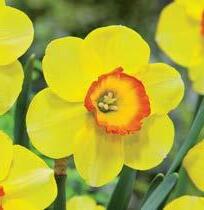
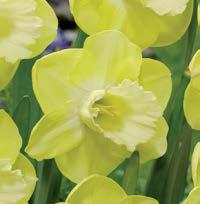
LARGE-CUPPED NARCISSI
owers with a deep salmon-pink cup.
white at centre with a lemon-yellow cup.
yellow owers with a yellow-orange frilled tumpet.
deep yellow perianth with a bright red attened cup shading to gold at the centre. FT: are clear sulphur-yellow with a broad perianth and a large frilled crown. Very proli c. The best all-round da odil. bright white owers, with an apricot-pink cup ribbed edge. Sturdy excellent old timer. Large yellow perianth with open cup extending to orange at the edge. Good grower and ne increaser. white perianth with large at saucer-shaped crown, which opens lemon but soon turns white. Excellent for naturalising. petals with bright orange cup. with a frilled orange cup. rounded petals with a straight cup frilled at the rim with a green centre. with pure white petals, vivid pink cup, yellowish-white towards the centre. Often deep clear yellow perianth, slightly frilled cup of bright crimson-red which is sunproof. Strong grower. a yellow cup with an orange frilled edge. large and well formed ower with creamy-white perianth and bold orange cup. One of the best for naturalising. Flowers remain in perfect condition for a long time.
Order code: SBP01
Surprise Bulb Parcel at £25 (inc. VAT) plus P & P. This will contain a minimum of £45 worth of bulbs (at full retail prices) and at least 6 different varieties. Each variety is individually packaged and clearly labelled along with planting instructions.
Division 3
SMALL-CUPPED NARCISSI
The short orange-red cup is frilled and forms a pleasing contrast to the attractive smooth pure white perianth.
white perianth with a green cup, edged with yellow.
green-eyed beauty with the very palest yellow rounded and overlapping perianth segments. FT: April. FH: 35 cm (14”). BS: 14/16 cm.
A delightful ower; snow-white perianth with very small at white cup shaded emerald-green in centre, sweetly scented. Outstanding.
orange petals with a small frilled coral-red cup.
smooth white perianth with green shallow bowl-shaped cup, edged deep yellow. Recommended.
Division 4
Double Daffodils
tall owers interspersed with deep orange segments. large golden double ower of great substance and charm. the large outer perianth surrounds layers of shorter petals. petals with a lemon-yellow pleated collar around a compact yellow and ivory centre. Vigorous and long-lasting. fully double scented golden-yellow Jonquil, very free- owering, bearing 1 to 3 owers on stem. The small bulbs are of true Jonquil character. Very old variety. FT: March. FH: 15 cm (6”). BS: 8/+ cm. owers interspersed with peachy-pink segments. owers.
Pretty little dwarf da odil with narrow pointed twisted petals, light yellow shading to deep yellow towards centre, sometimes having a slight tinge of green.
15 cm (6”). BS: 10/+ cm.
Entirely distinct multi-headed dainty double white owers with tiny orangeyellow petals interspersed in the centre. Excellent garden and forcing variety. Sweetly scented.
Creamy-white petals with a centre cup lled with white and orange-yellow segments.
BS: 14/+ cm.
A superb double with overlapping golden-yellow petals, interspersed with smaller bright orange-red ones in the centre of each ower. Strong sturdy habit.
40 cm outer petals with yellow and white frilled centre. cm. white blooms with multiple layers of petals.
BS: 14/16 cm.
Large creamy-white ower, broad overlapping outer segments with a centre of double petals intermingled with soft yellow.
30 cm (12”). BS: 14/+ cm.
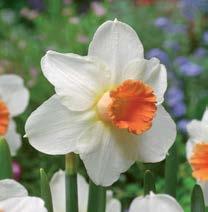
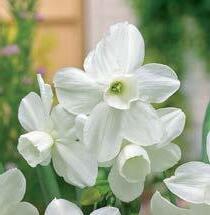
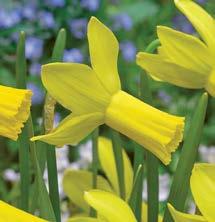
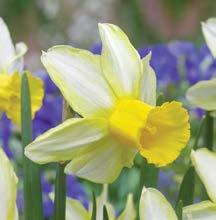
Division 5
Triandrus Narcissi
Some of the prettiest and most graceful of the smaller Narcissi. They naturalise splendidly in semi-shaded areas.
yellow scented owers. Very free- owering producing multiple stems with up to 5 owers each.
multi-headed owers. Fragrant.
small, drooping owers, with bell-shaped crown and re exing petals, are pale canary-yellow, borne 2 or 3 on a stem.
fading to creamy-white. 3-5 stems per bulb. 2-3 owers per stem.
ivory-white rounded owers per stem. Outstanding.
cm.
Creamy-white owers, up to four stems per bulb and each stem producing 2 to 4 owers. Outstanding. FT: April FH: 35 cm (14”) BS:12/+ yellow owers with a strong perfume, 3 to 4 stems from every bulb with or more blooms on each. cm
BS: 12/+ cm.
Sometimes called the ‘Orchid Da odil’. A lovely late- owering hybrid with pure white owers, 2 to 4 on a stem. Splendid in garden or pots. Fragrant.
Generally considered to be one of the best triandrus hybrids. Exquisite glistening pure white owers with a tinge of cream at the base of the crown. 4 to 5 on a stem. Free- owering. FT:
Division 6 DWARF CYCLAMINEUS
Best known for their re exing ower petals, which resemble those of cyclamen, they are among the earliest to ower and are ideal for rockeries, pots, window boxes and tubs.
swept back white petals with a pink trumpet ru ed at the edged.
25 cm (10”). BS: 12/14 cm.
One of the nest. Yellow perianth slightly re exing with a golden-yellow trumpet, prettily frilled at margin. Flowers profusely.
This pretty hybrid with de ned re exed soft yellow perianth has a striking cup which opens yellow and develops to orange as ower ages.
cm.
Outstanding and distinct, having re exing creamy-white petals with a primrose cup. Free- owering. Excellent for growing in pots.
cm.
Golden re exed petals with long true orange trumpet. Ideal for planting in groups in the rockery or garden. Slightly scented.
cm.
white petals with a deep pink cup.
Soft yellow petals that blend to white at the centre with a golden-yellow trumpet. Long-lasting.
February-March. FH: 30 cm (12”). BS: 12/+ cm.
owers with a long yellow trumpet.
FH: 25-30 cm (10-12”). BS: 12/+ cm.
Sugar Dipped Snowy-white petals surround a heavily ru ed yellow cup edged with white.
March-April. FH: 25 cm (10”). BS: 12/14 cm.
Variety Mix A balanced mix of yellow, white, pink bicolour varieties.
FH: 20-30 cm (8-12”). BS: 12/14 cm.
For your convenience www.dejager.co.uk offers a wholesale section.
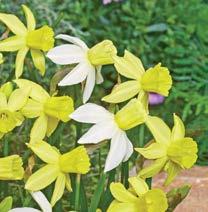
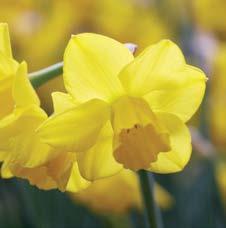
Jonquilla Narcissi
All sweetly fragrant, Jonquilla Narcissi have slender foliage and stems bearing from 2 to 6 owers with small cups.
yellow outer petals with an orange-yellow corona. Two owers per stem.
yellow owers with deep orange-yellow cups. Six to eight owers per stem.
of up to 6 very strongly scented, deep yellow owers to a stem. Freeowering.
petals with light pink cup.
yellow owers changing to white with pale apricot cup. Two to three scented owers per stem. FT: April. FH: 35 cm (14”). BS: 12/14 cm.
Plenus). Producing up to 4 deep yellow double owers. Very fragrant. This is the true ‘Queen Anne’s Double Jonquil’.
April. FH: 35 cm (14”). BS: 10/+ cm.
deep yellow owers with up to four stems per bulb and one to four owers per stem. FT: May.
yellow owers with orange-yellow cup, slightly ru ed at the edges.
An unusual colour combination but a very attractive variety. Perianth greeny lime-yellow; the small cup opens in the same shade as perianth but becomes nearly white as the ower ages. Two to four owers per stem.
It opens as a pale bicolour but soon turns white. One to three owers per stem, very vigorous and proli c.
March-April.
28 cm (11”). BS: 12/14 cm.
Looks delicate but is actually very robust. Two to three sweetly scented owers per stem.
Soft lemon-yellow owers with a slightly darker cup. Long-lasting fragrant owers.
white owers with cream cups. Two to three blooms per stem. Fragrant.
owers of an intriguing shade of yellow with at eye. One of the most perfect of all da odils. Very rapid increaser.
owers with re exed petals, two to three blooms per stem. Fragrant.
of Sailboat and Yellow Sailboat.
Division 9
Poeticus Narcissi
Traditionally known as the ‘Poet’s Narcissi’, these ageless favourites have a very large white perianth with small cup in contrasting colours. They impart a lovely fragrance throughout the garden and are known to naturalise very well.
N0561 Actaea
Division 12
Miscellaneous
Large ower with snow white perianth and a conspicuous canary-yellow eye edged bright red. Excellent for naturalising. FT: April. FH: 40 cm (16”). BS: 14/16 cm.
This group contains varieties that do not t into the other divisions.
N0673 Tete-a-Tete
N0677 Tete Boucle
N0674 Toto
Bright yellow owers with paler yellow trumpet. One to three blooms per stem. One of the best all-round Narcissi ever. Superb naturaliser. FT: March. FH: 15-20 cm (6-8”). BS: 14/16 cm.
A double variety of Tete-a-Tete, the buttercup-yellow petals are interspersed with orange tufts. FT: March. FH: 15-20 cm (6-8”). BS: 12/+ cm.
White star-shaped owers with creamy-yellow trumpet that soon fades to white. 1-3 blooms per stem. FT: April. FH: 20 cm (8”). BS: 10/+ cm.
Per 20 6.55 Per 100 30.30
Per 20 8.65 Per 100 40.00
Per 20 15.20 Per 100 70.30
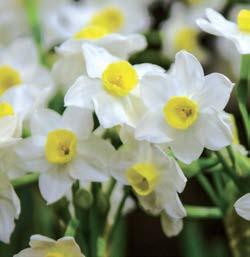

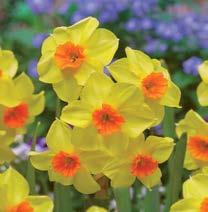
Division 8
Tazetta Narcissi
A multi- owering strain. Vigorous growers with strong erect foliage and bearing heads of large well-formed owers, some deliciously fragrant.
A strong stem with a plethora of white and yellow owers. 16 owers per stem is not uncommon. Outstanding. Scented.
Outstanding, with 3 to 4 owers on strong stems, white perianth with fully double creamy-white centre with pale yellow shades. Sweetly scented.
40 cm (16”). BS: 14/16 cm.
with a pale-orange cup. Fragrant.
heads of 4 to 6 owers with broad pure white petals and a bright orangescarlet cup. Scented. FT: April. FH: 40 cm (16”). BS: 12/14 cm.
headed golden-yellow owers with deep orange cups. Nicely scented.
cm (16”). BS: 12/+ cm.
charming fragrant Tazetta, 2 to 4 creamy-white owers per stem, with contrasting at lemon-yellow cup. One of the best.
FH: 15 cm (6”). BS: 12/+ cm.
A superb dwarf, having sti dark olive-green foliage. The stems carry several beautiful small nodding owers with glistening white perianth and creamy-lemon cup. Scented. FT: April. FH: 30 cm (12”). BS: 14/+ cm.
yellow sport from well-known Cheerfulness; a most lovely ower of delicate colour and sweetly scented.
Division 10 SPECIES
Ideal for rock gardens and wild parts of the garden, for outdoor pots or in the cold greenhouse. Can be left to grow naturally and will improve the longer they are left.
N0582 Canaliculatus Heads of 3 to 4 sweetly-scented owers, white perianth and golden-yellow cup; erect blue green foliage. FT: March-April. FH: 15 cm (6”). BS: 12/+ cm.
N0584 Golden Bells
A sport of n. Bulbocodium. Very free- owering. One bulb will produce up to 15 rich golden-yellow owers. FT: March-April. FH: 20 cm (8”). BS: 7/+ cm.
N0591 Little Gem Pale gold miniature trumpet narcissi. FT: March-April. FH: 15-20 cm (6-8”). BS: 8/+ cm.
N0585 Obvallaris (The Tenby Da odil). Medium-sized owers of pleasing symmetry, yellow perianth and trumpet. Very early. Does well grown in partial shade and is one of the nest varieties for naturalising. FT: March. FH: 28 cm (11”). BS: 12/+ cm.
N0586 Pheasants Eye (syn. Recurvus). Pure white perianth, yellow eye margined deep orange-red. Fragrant, a favourite old variety for massing in woods, grass, etc. The latest of all da odils to ower. FT: April. FH: 40 cm (16”). BS: 14/+ cm.
N0587 Pseudonarcissus (Lobularis)
N0590 Spoirot
N0595 White Petticoat
Division 11
SPLIT CORONA
(Lobularis - The Lent Lily). Perianth creamy-white with yellow trumpet. A small plant which is suitable for naturalising in grass, woodlands, etc. May need a few seasons before becoming fully established. FT: March. FH: 15 cm (6”). BS: 5/6 cm.
Ivory-white narrow pointed perianth and a deep bow-shaped cup with a slightly wavy rim. FT: March-April. FH: 20 cm (8”). BS: 7/+ cm.
White funnel-shaped cups surrounded with short narrow petals. Grass like foliage. Ideal for pots and front of ower border.
FT: March-April. FH: 20 cm (8”). BS: 6/+ cm.
Distinguishing characteristic is a split cup or corona, so giving the owers an orchid-like appearance.
N0643 Cassata Greenish-white perianth with large pale yellow corona.
FT: March-April. FH: 38 cm (15”). BS: 14/+ cm.
N0653 Cum Laude White with unusual apricot frills at the centre. Stunning.
FT: March. FH: 25 cm (10”). BS: 14/16 cm.
N0670 Fire Drill
N0648 Tripartite
Per 20
Per 100 73.75
Per 20 8.65 Per 100 40.00
Frosty-white petals surrounding a ru ed bright pink cup.
FT: March-April. FH: 40 cm (16”). BS: 14/16 cm. Per
Strong late- owering plant quite distinct from other split coronas, bearing 2 or 3 shining lemon-gold owers per stem; the split corona lies almost at on the perianth segments. Good increaser. FT: April. FH: 30 cm (12”). BS: 12/+ cm. Per
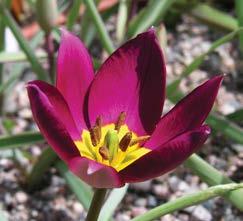
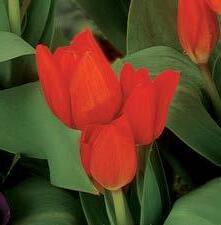
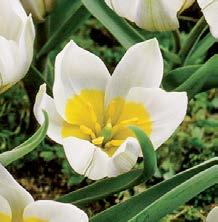
Rare And Fine Tulip Species
Tulips will thrive in any type of well-drained soil and locality, but after they have owered be sure to remove any decaying petals or foliage from the soil. For best results plant late September-October onwards, when temperatures drop. All our quality tulips are Top Size.
owers ushed with orange.
red with yellow margin, interior green, purplish base.
very interesting new member of the Clusiana family. Eye-catching deep rosyred outer petals are set o by sparkling white inner petals and a steel blue base.
yellow with soft pink blush.
with a purple base. Fragrant.
long-lasting species, exterior magenta rose with a green tint, cyclamen-purple with yellow base.
petals, paler on the inside, with large yellow centre.
vermillion red owers with sharply pointed petals. Narrow, glaucous leaves with strong wavy edges.
rosy-purple, with striking deep blue centre edged white. One of the most e ective species.
owers with a rich brown throat.
owers ushed with orange, with thin grey-green leaves.
white owers slightly tinged greenish-pink, with golden-yellow centre.
of a prominent position in any rockery, a brilliant orange-scarlet dwarf variety, 4 to 6 owers on each stem. Excellent for tubs.
owers with tiny ecks of orange. Up to 3 owers per stem.
with bright green leaves.
Delicate pale silvery-lilac owers with large bright yellow centre. The broad shining dark green leaves are unique. Excellent naturaliser.
This sweet-scented golden-yellow tulip is ushed green. Excellent naturaliser.
FH: 30 cm (12”). BS: 6/+ cm.
T1010 Tarda
T1011 Turkestanica
T1023 Species Mix
One of the most desirable tulips, white with a bright yellow base. 3 to 6 owers per stem. Seeds freely.
FH: 10 cm (4”). BS: 8/- cm.
This interesting species has, per stem, 5 to 9 snowy white owers with a green and bronze ush on the exterior. Long-lasting.
FH: 18 cm (7”). BS: 7/8 cm.
A mixture of small dainty varieties ideal for the rockery.
FH: 10-15 cm (4-6”). BS: 5-8/+ cm.
TRUE DEFINITION of tulip sizes in all sections barring Species. 12 cm = TOP SIZE 11-12 cm = Second size 10-11 cm = Third size.
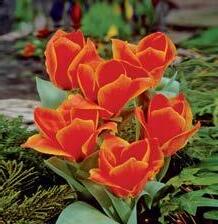
The Bicolour Collection
blooms with rich red streaks.
45 cm (18”).
with rich purple brush strokes and lilac feathering.
owers with deep red streaks.
GREIGII HYBRID TULIPS (March-April Flowering)
Often called ‘Peacocks’ because of their beautiful variegated leaves. Superb in window boxes, patio and balcony pots.
edged yellow with black base.
owers, bronze inside with a black base, and mottled leaves.
amed with pale pink markings.
attractive rose exterior with apricot-rose inside.
scarlet. A most fascinating hybrid on account of its very dark, brownishpurple marked, spreading mottled leaves.
on each stem, which are an unusual shade of jasper-red tinged with vermillion. Leaves are beautifully mottled. Very sturdy.
mixture of delightful colours.
KAUFMANNIANA TULIPS (March-April Flowering)
The earliest to ower, starting in March. They have broad leaves which are often beautifully mottled. Very suitable for window boxes and rock gardens.
with a darker base.
orange ames on an orange-red background with a deep yellow base.
FH: 20 cm (8”). BS: 12/+ cm.
lighter inside with a buttercup-yellow base. Mottled leaves.
BS: 12/+ cm.
outstanding currant-red edged yellow. Inside Indian-yellow. Very attractive
How deep do I plant bulbs?
The basic rule for all bulbs is to plant them at a depth equal to about twice the depth of the bulb itself.
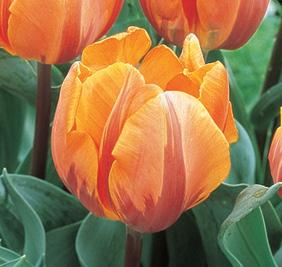
FOSTERIANA TULIPS (March-April Flowering)
EARLY SINGLE TULIPS (Mid-April Flowering)
faintly tinged with red. An outstanding tulip. Fragrant.
outstanding large egg-shaped rich rose. Very sturdy garden plant as well as superb forcer.
owers with a white edge.
orange with each petal distinctly marked with purple ames rising from the base. Long-lasting.
superb ower of unusual mallow-purple with dull lilac-purple ame; anthers chrome yellow.
hints of pink and orange yellow.
strong sturdy stems.
striking mixture of the Candy, Purple and Sunny Prince varieties.
For larger quantities please telephone 01622 840229 for prices.
OUR GUARANTEE
Your bulbs should arrive in perfect condition.
If you are dissatisfied for any reason at all, please contact us and we will willingly offer you a replacement or refund.
EARLY DOUBLE TULIPS (Mid-April Flowering)
These are very sturdy and excellent for bedding, window boxes, patio tubs and windy locations.
owers, petals edged with white.
Darwin
HYBRID
A fragrant ower of soft creamy-yellow with occasional green markings on the outside petals; inside pale yellow with ivory-white mid-vein.
Highly recommended for exposed positions, this mixture is selected by us and is superior to other mixtures usually sold.
TULIPS (Late April-May Flowering)
These modern varieties are a cross between Darwin and Fosteriana. The rounded owers are the largest yet introduced. Most striking when planted in clumps in the border etc.
A superb large oval-shaped ower on strong stem. Exterior cherry-red with yellow base; inside signal-red, with black base edged yellow. Long-lasting.
Excellent brilliant mandarin-red with a broad blaze of golden-orange at the petal edges. Long-lasting.
Fine large deep golden-yellow with occasional red specks when fully developed. Strong stems.
white, goblet-shaped owers on tall sturdy stems.
A lovely ower of old rose fading to ivory-white at petal edges as it ages. Sturdy and long-lasting.
amed deep signal-red. Very sturdy and long-lasting.
bright pillar box-red owers which have a yellow and black base.
55 cm (22”). BS: 12/+ cm.
on pale rose ground with a neyron-rose ame and a broad shrimpred feathered edge.
with a warm pink glow.
owers. Sturdy and long-lasting.
of World Frienship and Pink Impression.
glorious selection of brilliant colours, specially chosen by ourselves from distinct varieties.
After you plant your tulips, try planting crocus over the top and enjoy these heralds of spring before the tulips.
MID-SEASON TULIPS (April-May Flowering)
This class lls the gap between the low-growing early tulips and the tall lates. The colours are bright and long-lasting. The stems are short and sturdy.
creamy-white owers, petals edged with deep violet-mauve.
petals with a pink-blush and yellow-orange edge. Fragrant, long-lasting as cut owers.
owers with creamy-yellow edges.
of uniform Tyrian rose held on strong erect stems. Ideal for border or bedding. FT: petals edged with creamy-yellow. rich pink owers. Long-lasting on strong stems. warm deep purple, veined beetroot-purple. Strong stem. Long- owers also making excellent cut blooms. mix of Royal Virgin and Negrita. o er an extra ne mixture in a special combination of named varieties. suitable for exposed positions.
Each petal margined sulphur-yellow with large central ame of darkest maroon-black. Filaments Dresden-yellow with black-brown pollen.
An outstanding garden variety, exterior cardinal-red, inside blood-red, base dark bronze-green with narrow yellowish edge.
Order Early
FRINGED TULIPS (May Flowering)
These tulips will add a totally new dimension to the garden. All have delicate, clearly de ned, crystalline fringed petals.
two-tone ower, violet-purple petals lightening in colour towards the edge.
VIRIDIFLORA TULIPS (May Flowering)
These fascinating tulips are much sought after for the garden and by ower arrangers. Depending on the variety, the petals have varying amounts of green in them.
tones of apricot, broadly amed with green. A lovely petite tulip.
superb variety. The variegated leaves with a whitish margin set o the predominantly phlox-pink bloom enhanced with broad ames of moss-green.
edged with rose-pink.
FH: 55 cm (22”). BS: 12/+ cm.
Spring Green Ivory-white, feathered green, anthers light green. Very attractive and sturdy grower. FT: May. FH: 50 cm (20”). BS: 12/+ cm.
The Green Mile Graceful yellow owers with a lime-green stripe on each petal.
April-May. FH: 50 cm (20”).
Multiflowering Tulips
These bouquet- owering tulips produce at least 4 full-size owers per stem.
lemon-yellow owers fading to a creamy-white with deep red edges.
cm (16-18”). BS: 12/+ cm.
owers with rosy-purple feathering. Petals edged with purple. Four to ve blooms per stem.
Up to six owers per stem.
May Flowering Tulips
has large owers of rosy-red amed creamy-white.
of cherry-red edged scarlet. Recommended.
china-rose, su used apricot-orange edges. Very sturdy.
P. de Jager & Sons Limited have been selling top quality, top size bulbs for over 154 years. We cannot overemphasise the importance of size. Top size bulbs really do make a huge di erence both in terms of owering and naturalisation.
Smaller size bulbs will be less expensive but the results will be very noticeably inferior.
In order to illustrate the contrast in size, we have photographed a de Jager Amaryllis bulb beside one purchased from a garden centre. You can see the di erence! All de Jager top bulb sizes are published in our catalogues.
Special Themed Collections
These collections o er two varieties of bulbs in di erent colours from di erent divisions. The bulbs are packed separately to allow for planting as a mixture or in individual colours.
T2001 Collection 1 10 x Bicolour Tulip Flaming Flag and 10 x Mid-Season Tulip Negrita. FT: April-May. FH: 45-50 cm (18-20”). BS: 12/+ cm.
T2002 Collection 2 10 x Lily-Flowered Tulip Ballerina and 10 x May Flowering Tulip Violet Beauty. FT: May. FH: 50-60 cm (20-24”). BS: 12/+ cm.
T2003 Collection 3 10 x Bicolour Tulip Carnival de Rio, 10 x Fringed Tulip Paci c Pearl and 10 x MidSeason Royal Virgin. FT: April-May. FH: 40-50 cm (16-20”). BS: 12/+ cm.
T2004 Collection 4 10 x Fringed Tulip Huis Ten Bosch and 10 x Mid-Season Tulip Paul Scherer. FT: April-May. FH: 45-50 cm (18-20”). BS: 12/+ cm.
LILY-FLOWERING TULIPS (Early-Mid May Flowering)
These lovely and unusual tulips, unsurpassed for charm and elegance, were introduced in 1914. The varieties in this section form owers of fascinating beauty.
magni cent garden variety with long pointed petals of soft marigoldorange. The awlessly-formed owers have a delicious scent.
55 cm (22”). BS: 12/+ cm.
impressive performer, the elegant serpentine curves of this rich deep purple-violet will produce a picture beyond one’s expectations.
lily- owered variety. Graceful petals of creamy-yellow with violet-rose edge. Truly worthy of its name. FT: May. FH: 45 cm bright yellow owers on strong stems. outstanding white with purple-red feathered ame. Petals are amed on both sides. owers with darker shading through the centre white longish-shaped ower with strong re exing petals borne on a strong stem. Long-lasting. FT:
In a wide range of colours, this mixture is superior to the mixtures usually o ered. Excellent for cutting as well as bedding.
Flower Bulb Care
Unpack bulbs on arrival, or at least separate the bags and open them. It is essential to have fresh air circulating between opened boxes and bags. Remember: fresh air, circulation, even temperatures, are the key factors to good results.
For your convenience www.dejager.co.uk offers a wholesale section.
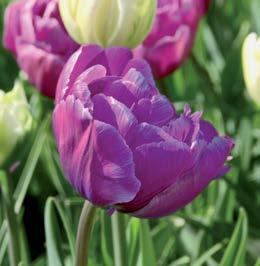
PAEONY-FLOWERING TULIPS (April-May Flowering)
This section of April-May owering tulips will create an outstanding e ect in the garden. Robust in habit, their large owers resemble paeonies. Not recommended for forcing.
beautiful tulip. Pale apple-blossom pink, lighter at edge. Fragrant.
owers with hints of yellow on the inner petals.
outstanding garden plant. Sport of ‘Queen of Night’. Beautiful double owers of deep maroon-black. FT: gorgeous example with a multitude of deep purple petals. attractive; sparkling white double owers with deep red feathering. The white rim to the silver-green foliage is most eye-catching. Long-lasting. standing on strong green stems. white. Strong and long-lasting. Excellent for windy locations.
Flowers are nasturtium-orange with garnet-red ame; base paeony-like ower. blooms with a feathered white edge. Strong stems. simply stunning pastel mix akin to a Monet canvas.
PARROT TULIPS (May Flowering)
Parrot Tulips make a colourful impact in the late spring garden which few other tulips can match.
petals with green stripes and ame-coloured feathering.
The owers are of perfect Parrot form. Exterior deep-purple, inside blackishpurple, with exceptionally beautiful laciniated petals.
elegant creamy-white owers edged with rose-pink and green markings.
The fringed petals combine bright white with amingo-red and touches of green. Vibrant blooms open to a massive 7”.
ushed green with a white base.
purple owers with petals frilled at the edges. Strong stems.
owers with darker markings on the outside of petals.
pure white owers feathered with green streaks.
A gorgeous mix of colours. It is a superior mixture and will produce the most artistic tulips for oral arrangements.
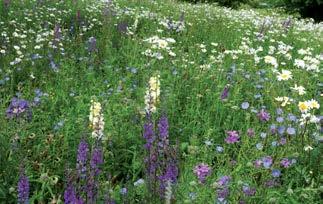
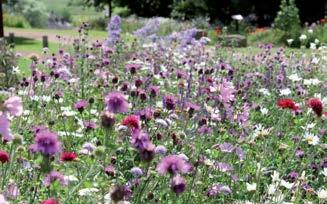
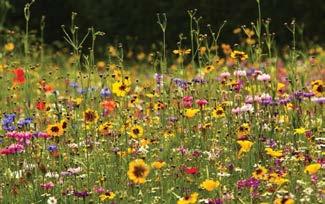
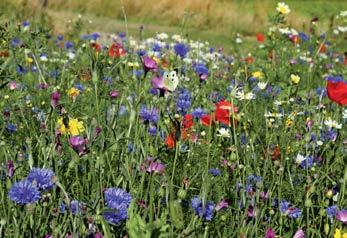
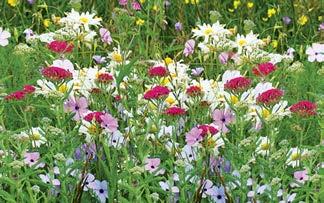
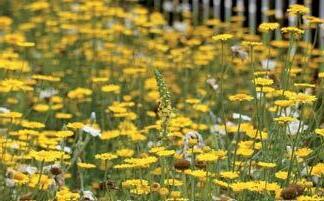
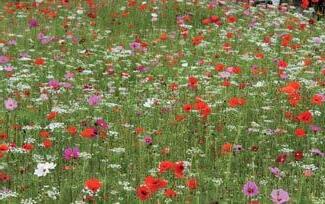
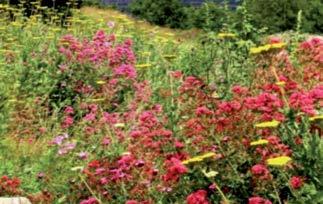
Pictorial Meadows Mixtures
These Meadow Mixtures are carefully blended seed mixes of native and non-native hardy species, designed to provide high quality owering displays. They have been developed following several years of intensive trials at the University of She eld. Unlike other mixes that are available, they will ower and provide visual interest over an extremely long period of time (from summer through to late autumn) and are formulated to produce a succession of owering species.
They inject drama into large-scale commercial landscapes and create sparkling, complex and intricate pictures in the very smallest of spaces. They provide a colourful, wildlife-friendly replacement for mown grass; they can be sown formally in beds or to provide colour between shrubs, trees and perennials. Leeds City Council included a meadow mixture in their magni cent Gold Medal winning garden at the Chelsea Flower Show in 2010, and these mixtures have been used extensively in the Olympic Park.
Sow the Annual seed mixes at a rate of 2-3g per square metre in the spring - March, April or May - and they will produce superb colour displays within 8 weeks or so of sowing. The Perennial seed mixes all contain over 20 species of plants, and should be sown at a rate of 2g per square metre (except Purple Haze – 3g per sq. m.) from early autumn to late spring, with October/November being the best for medium to large scale plantings. Once established the meadow can be managed simply with an annual cut in late February.
SD111 Classic Annual Mix
The original Pictorial Meadows mix is illustrated in the main picture opposite (taken at The Eden Project) and produces stunning displays right through until late October/November. Starting out with white, blues, pinks and reds, the tapestry turns to reds, orange and yellow in the autumn. The mix has been carefully balanced for colour and succession of owering, and components include: Shirley Poppy, Californian Poppy, Corn ower, Fairy Toad ax, Tickseed, Red Orache and Larkspur. FH: up to 1m (39’’).
SD141 Cornfield Annual Mix
SD161 Pixie Annual Mix
A carefully selected mix of pretty corn eld annuals that will ower mainly in July and August, including: Field Poppy, Corn ower, Scentless Mayweed and Corncockle. FH: up to 1m (39’’).
A mix suited especially to more restricted or compact situations, but having the same long- owering characteristics of the standard mixture; components include: Fairy Toad ax, Red Flax, Shirley Poppy, Love-inamist, Candytuft and Blue Flax. FH: up to 50 cm (20’’).
A tall, dramatic, colourful, and long season meadow. It was initially designed to be sown over pure brick rubble on housing demolition sites, but nds itself equally at home in garden soils. This meadow o ers fantastic variety and is jam-packed full of species that work wonderfully together, providing drama and colour from early Spring, right through to late Autumn. On very low fertility soils, an annual cut and collect is not always necessary.
A owering meadow with a very long season, and complex and subtle colour combinations throughout the year. Also perfect for narrow borders and edges. Includes: Carthusian Pink, Dianthus carthusianorum, Hard Fescue, Festuca longifolia, Maltese Cross, Lychnis chalcedonica, Vipers Bugloss and Echium vulgare.
A warm, vibrant mixture for normal fertility soils. Mostly yellows and golds with white, hints of orange and ashes of later purples, our most popular perennial mix performs best in free-draining, sunny spots. Includes: Blackeyed Susan, Rudbeckia hirta, Sea Holly, Eryngium planum, Yarrow, Achillea millefolium, Yellow Ox Eye, Buphthalmum salicifolium.
A beautiful, cool, elegant combination for normal fertility soils, this mix will perform quite happily in semi-shade. Predominantly mauve and blue with billows of white and ashes of purple. Includes: Michaelmas Daisy, Greater Knapweed, Field Scabious, Wild Carrot, Perennial Flax, Purple Cone ower, Ox-eye Daisy and Columbine. FH: up to 50 cm (20’’).
A gorgeous, robust and very richly coloured carpet designed for a long owering season on normal fertility soils. Includes: Field Scabious, Knautia arvensis, Great Burnet, Sanguisorba o cinalis, Meadow Cranesbill and Geranium Pratense.
Frequently Asked Questions
Q. Is there any grass seed content?
A. There is no grass content to the mixes. Don’t mix with grass as it will kill o the owers.
Q. Can I just scatter the owers over existing grass to create a meadow e ect?
A. Unfortunately not - the seeds have to be sown on bare soil.
Q. Will the annual mixes self-seed?
A. Only some of the species in the annual mixes will. To get the same e ect you have to resow each year.
Q. Will birds eat the seed ?
A. No, they are too small for them to notice.
Q. Will the mixes work in Sandy/Chalky/Clay soil ?
A. Yes. They will work on all types of soil, but for these mixes, the better the soil the better the result.
Q. Do I need to water the seeds if it doesn’t rain once I’ve sown them?
A. For annuals no there is usually enough rain eventually and if you over-water they could rot before they germinate. However, if there is prolonged drought after you have sown then you could try watering once a week. Perennials are more demanding and we recommend irrigation in Spring.
Q. Will the mixes work in shady areas?
A. Yes, but the mixes do need sunshine at some point during the day.
Q. Can I combine the annual and perennial seed mixes?
A. We don’t recommend this, as each seed mix is carefully formulated to produce a speci c result.
Q. How long will the seed keep if I don’t use it all?
A. Usually for several years - keep stored in a cool dry place.
Please order early to ensure you obtain the varieties you require.
Planting Depth
Failures with bulbs are most frequently due to their having been planted too deep or too shallow. A good general rule to follow is to cover the bulb with soil one and a half to twice its own depth, measuring the bulb from the base to the shoulder. Thus a bulb measuring 2 inches from the base to the shoulder should be covered with 3-4 inches of soil. Always unpack bulbs on arrival and leave bags open so air can circulate until planting.
Top Quality, Top Size Bulbs
Flower
Name: Address 1: Address 2: Town: County: Daytime telephone no. (in case of queries): Postcode: de Jager Bulb Magic - Boost your Bulbs @ £8.29 per bottle Exclusive Greeting Cards - Pack of 8 @ £4.04
Special Instructions:
Catalogue No. Name of Varieties £ p Qty of Bulbs Method of Payment You Prefer: Cheque Visa Mastercard Maestro Credit Card Number Print Name: Signature: Validation/Security Code (Last THREE digits of Number of signature strip on reverse of card). Expiry Date: Issue No. 6 95
Top
Please use the correct catalogue number and quantity of bulbs required (not pack size)
If we are out of stock of a variety may we send a similar one of equal value?
Special Instructions:


